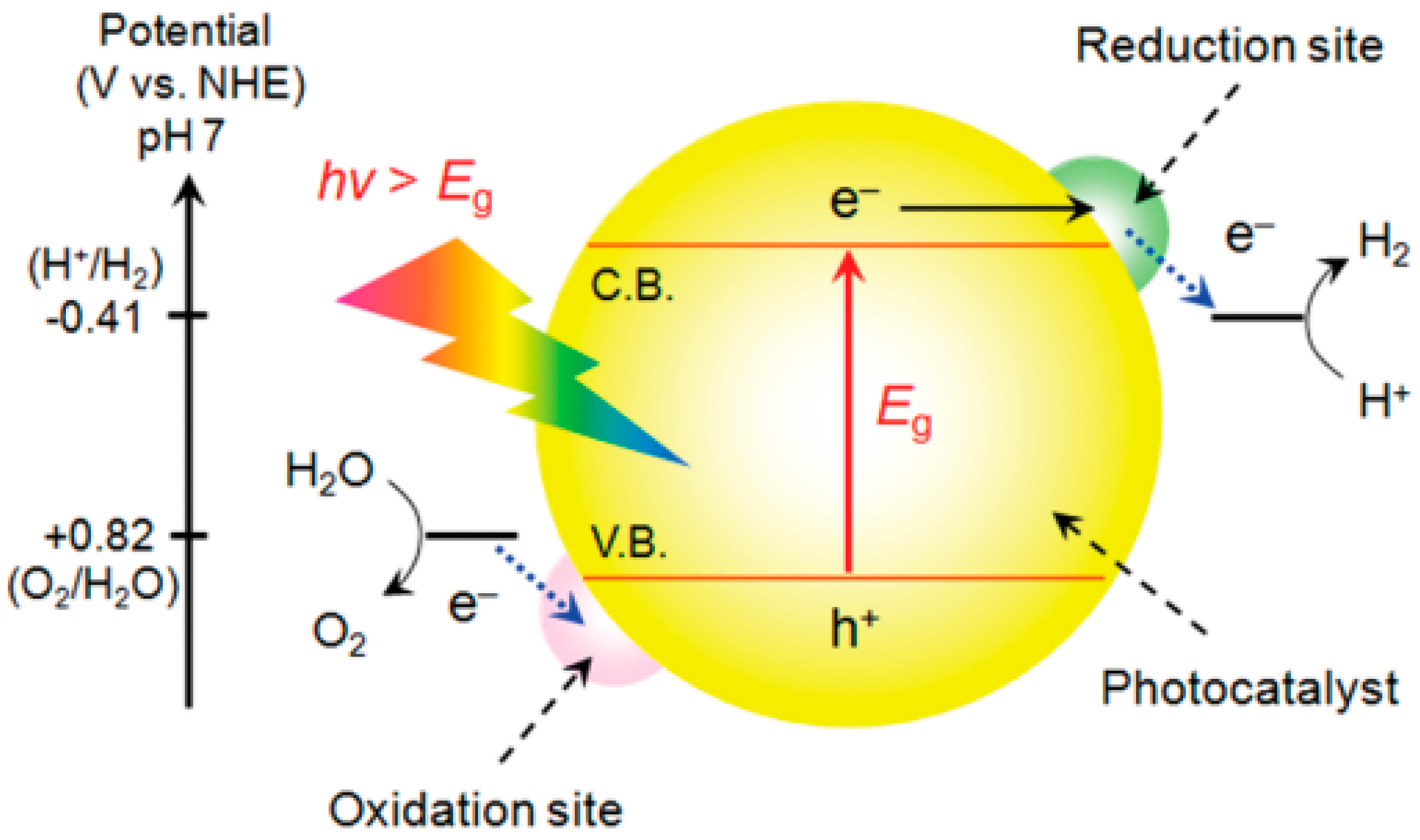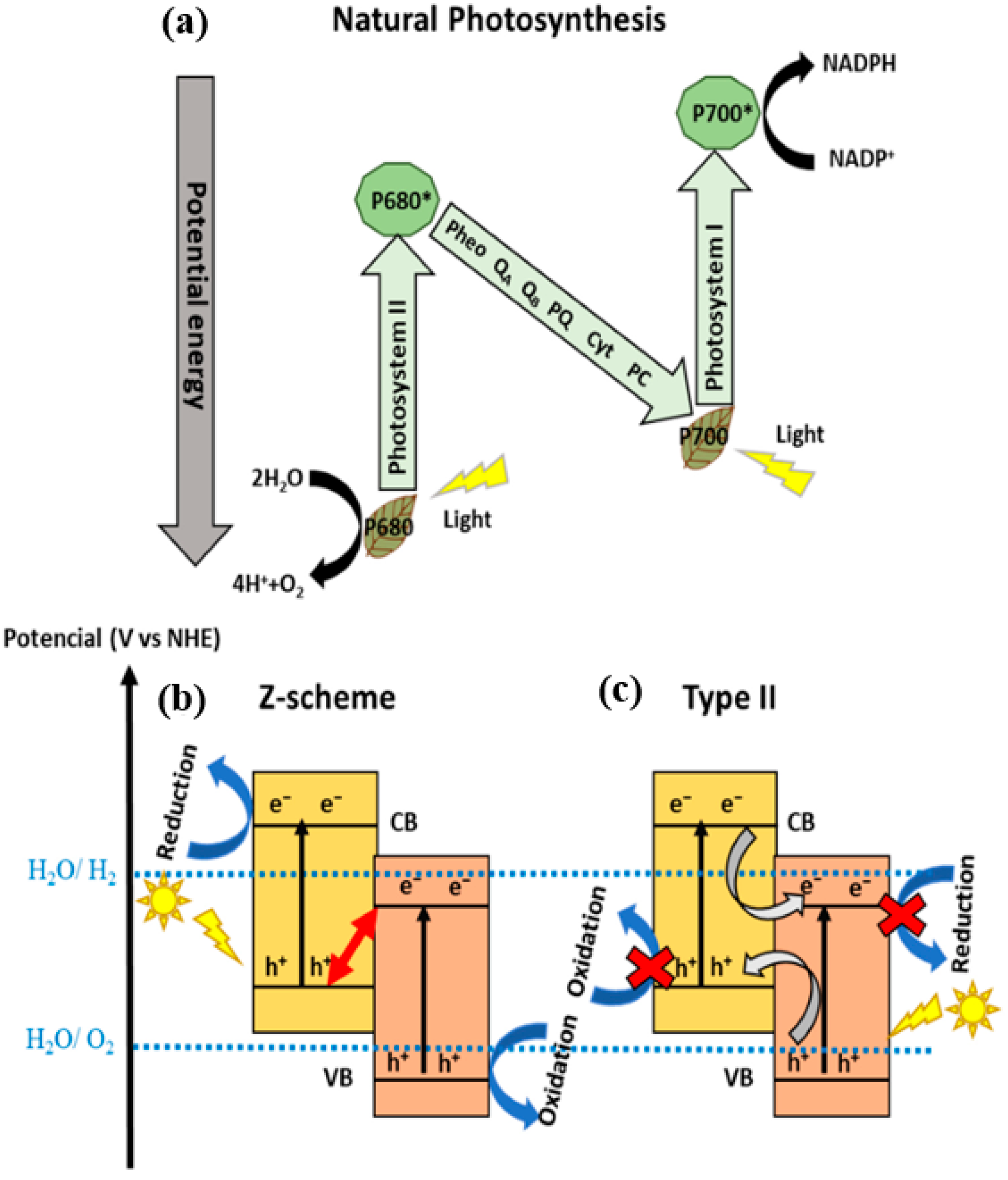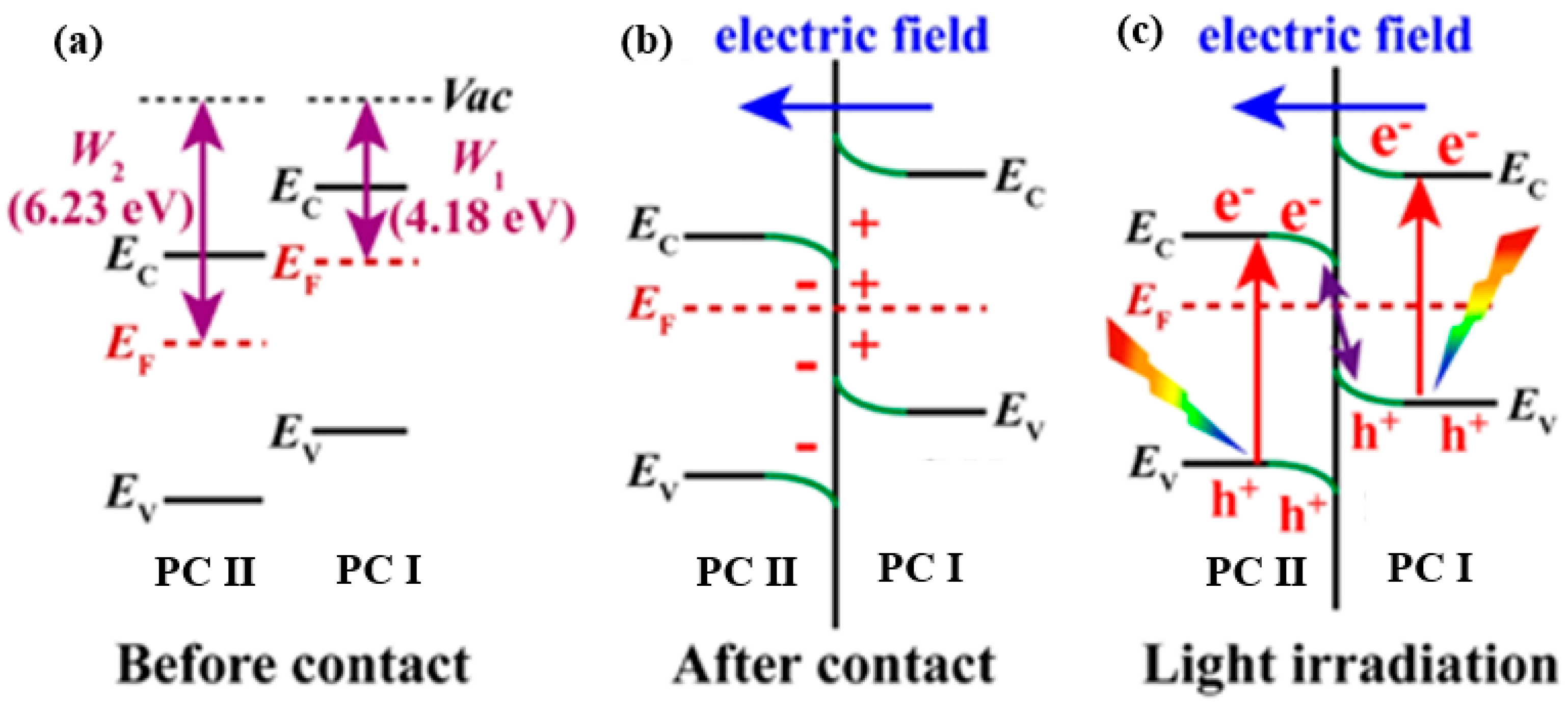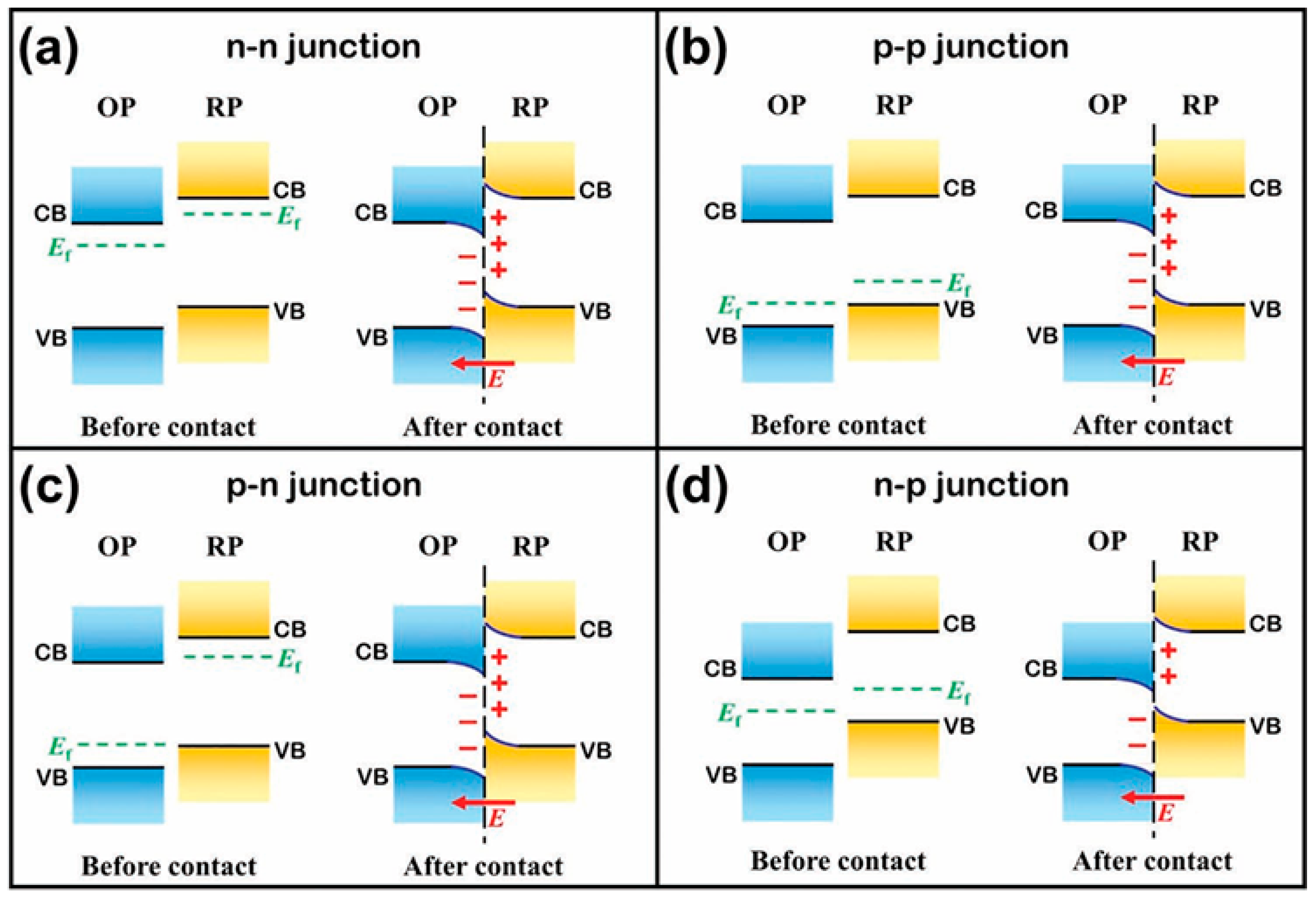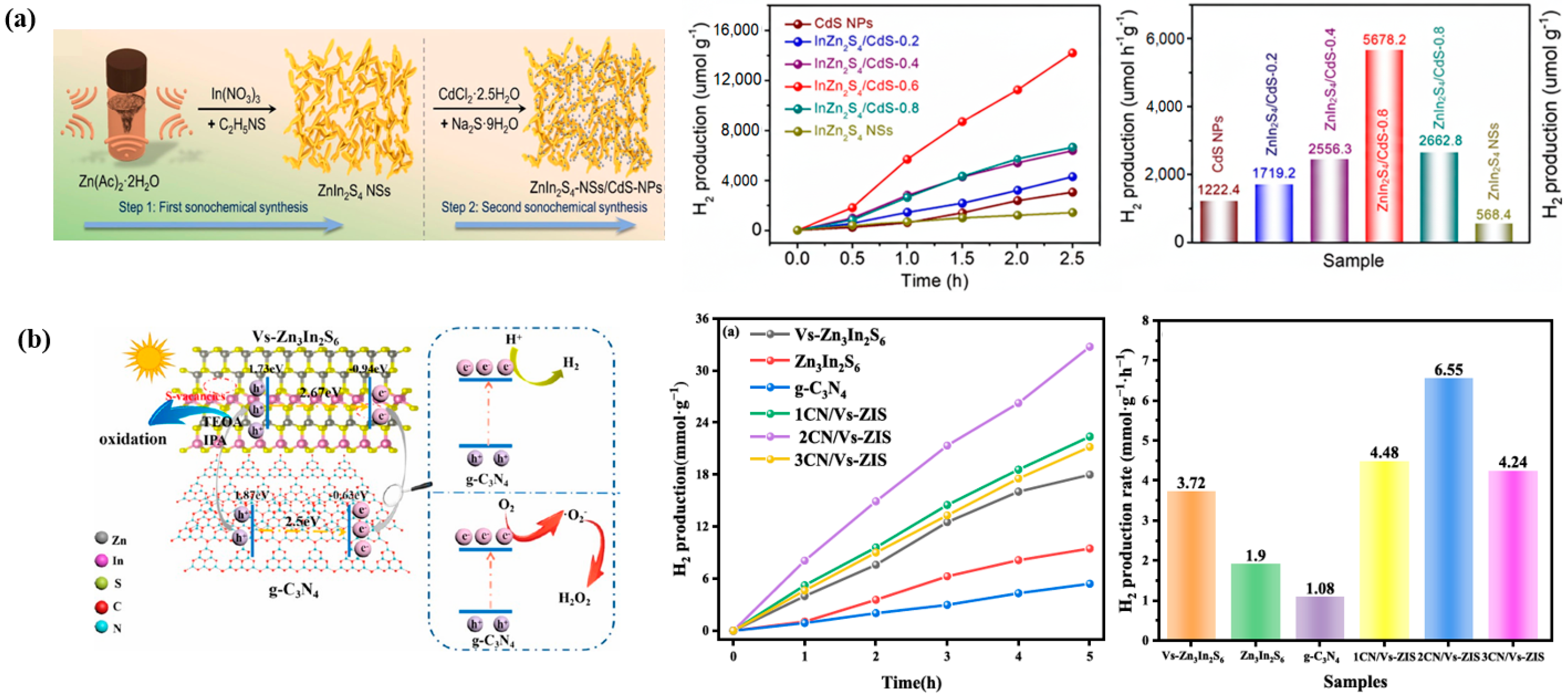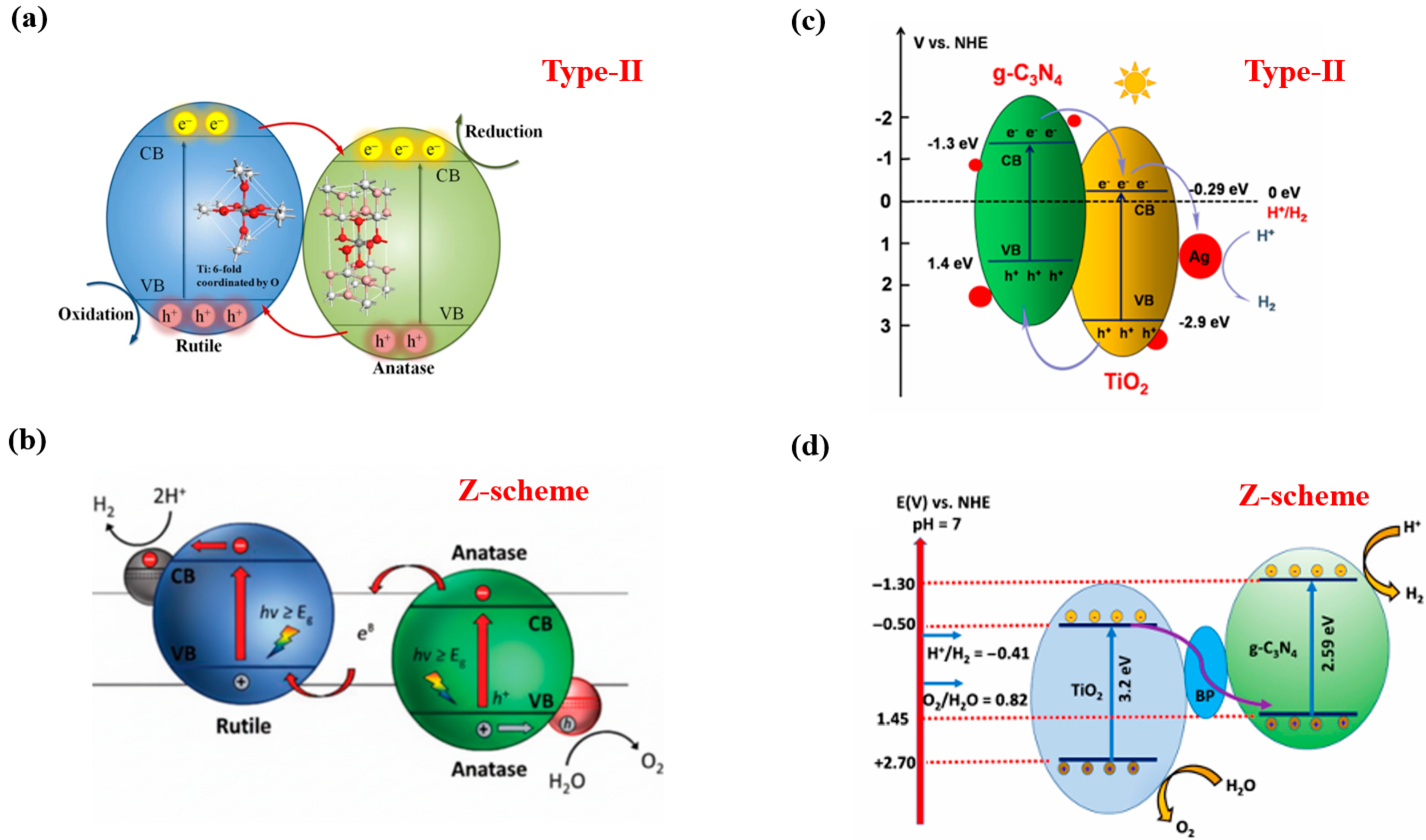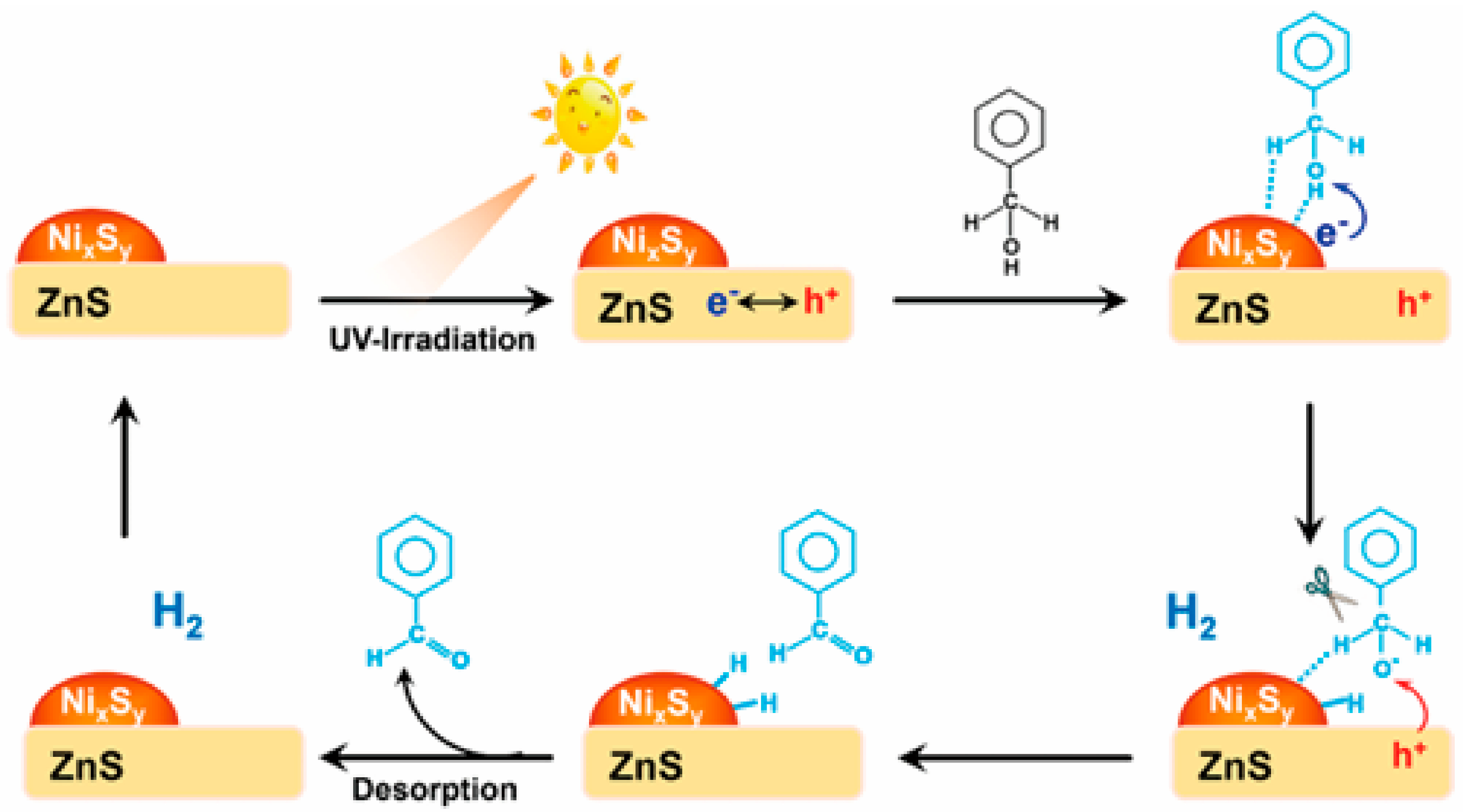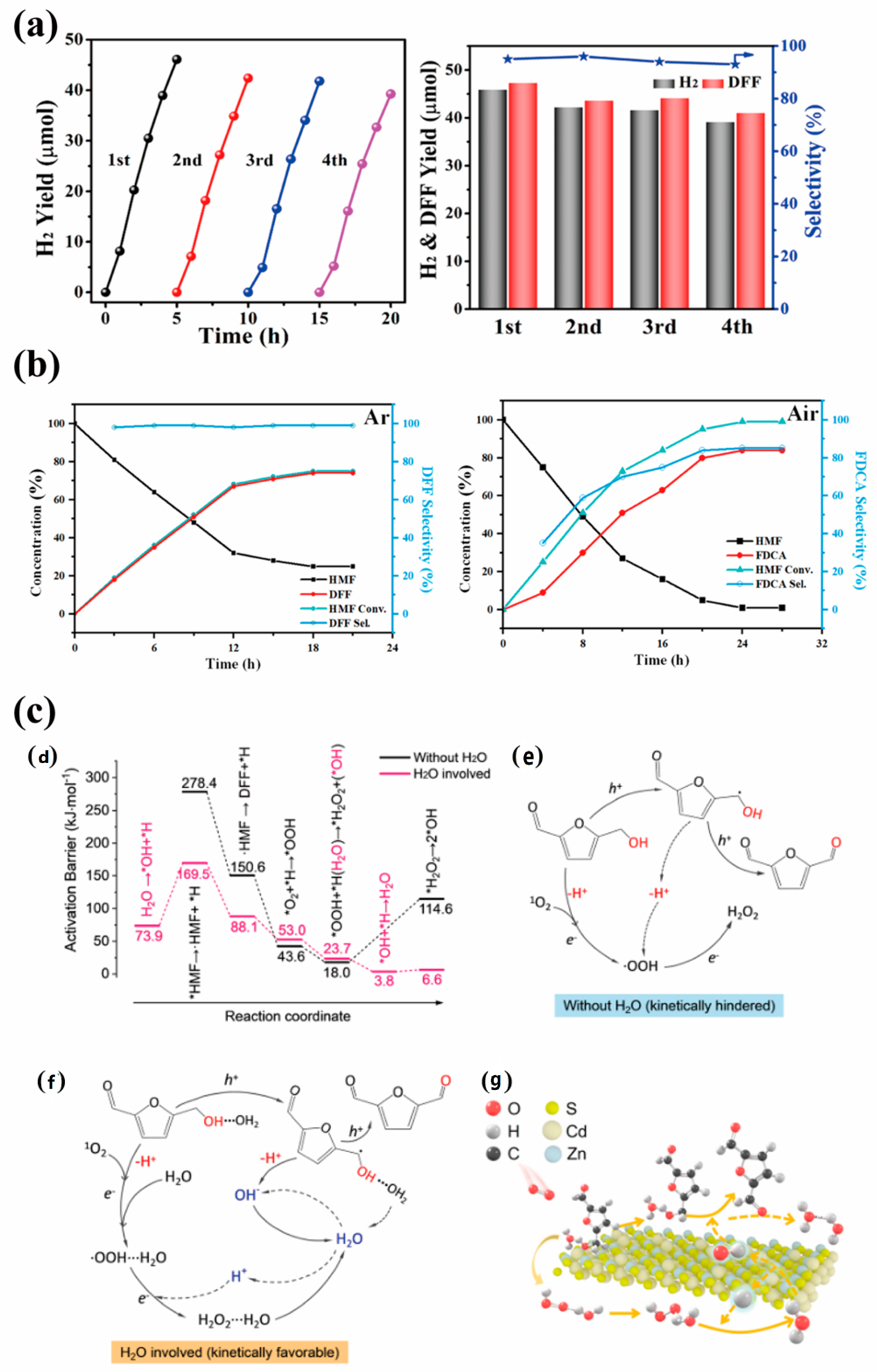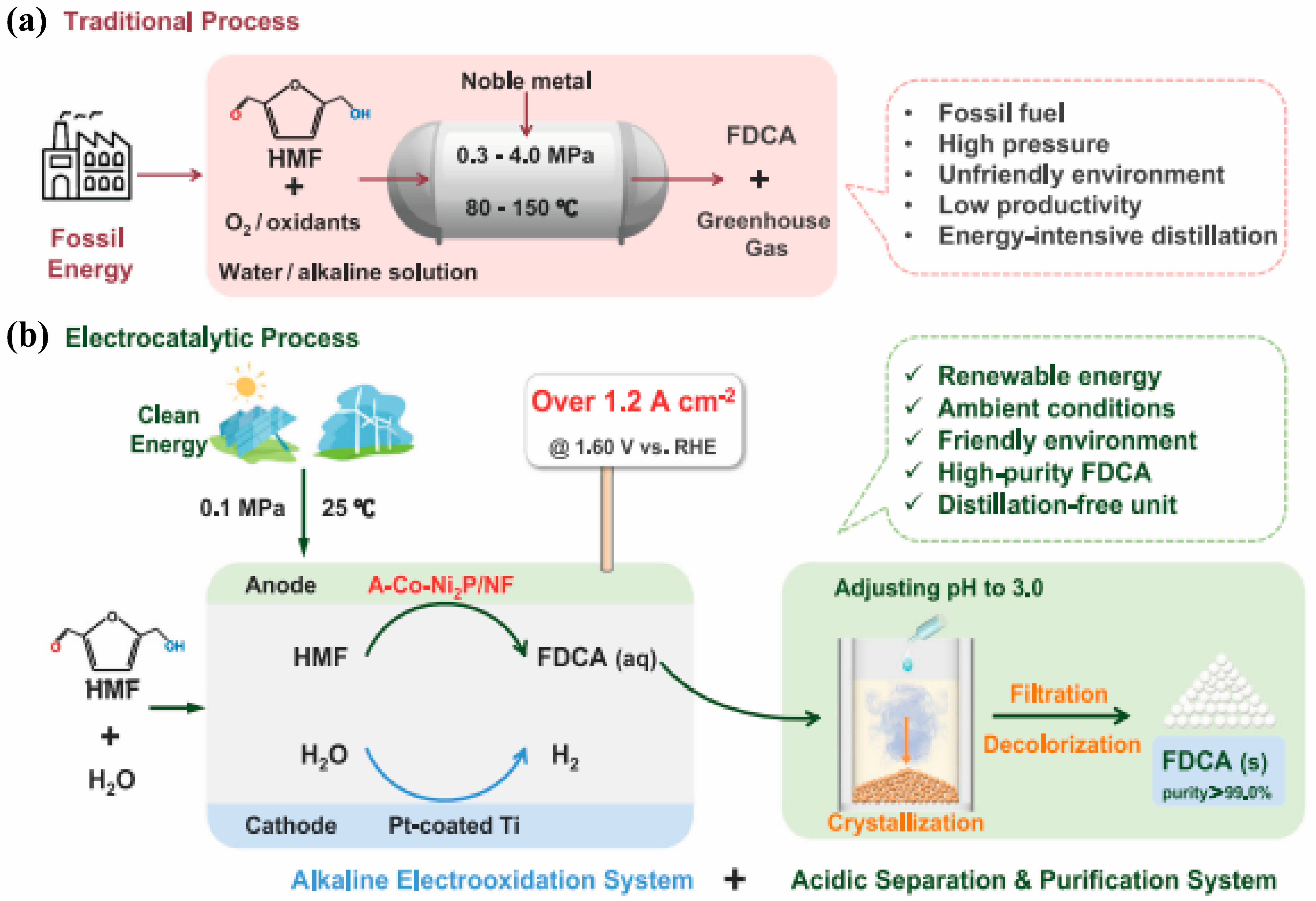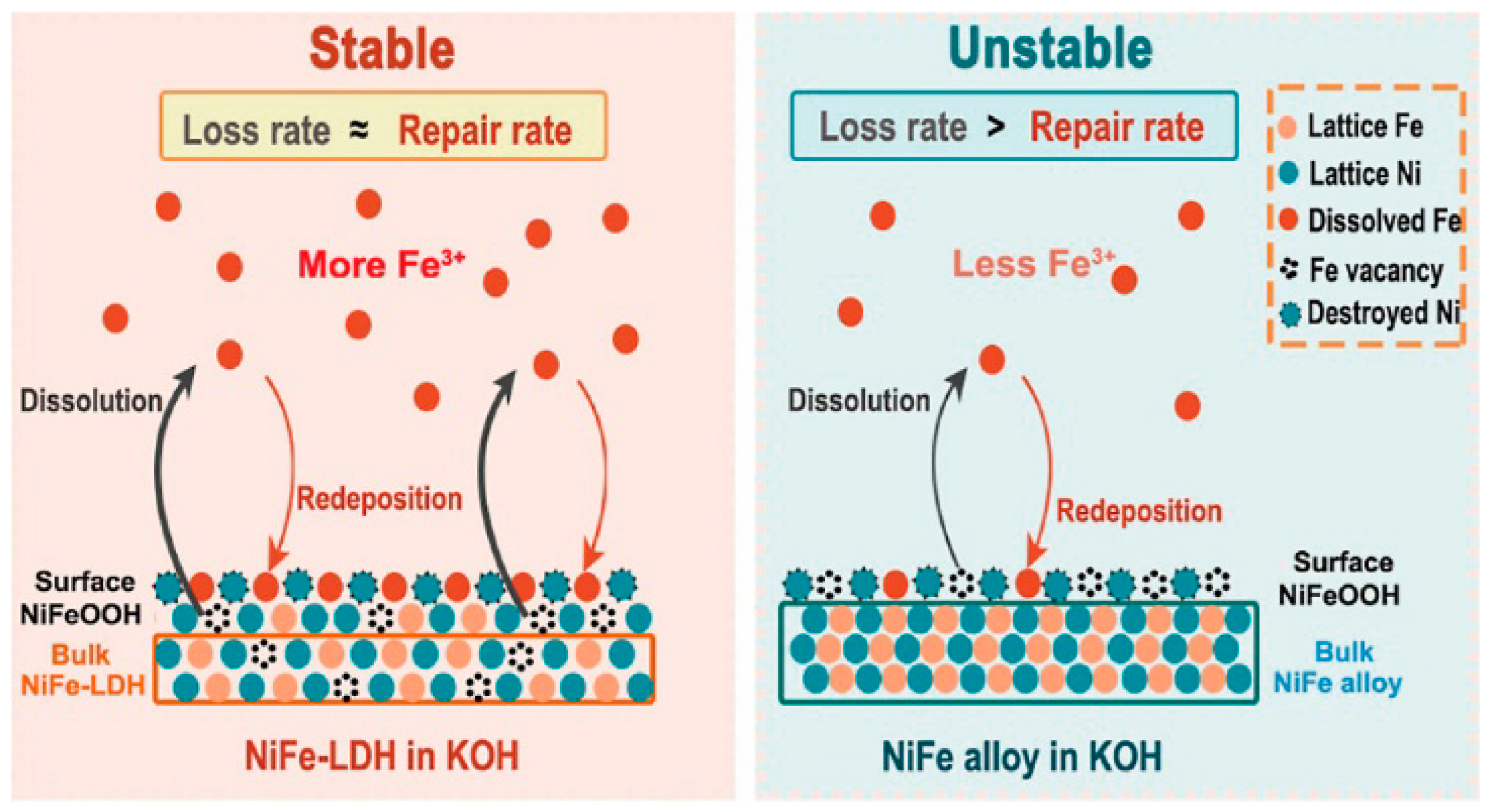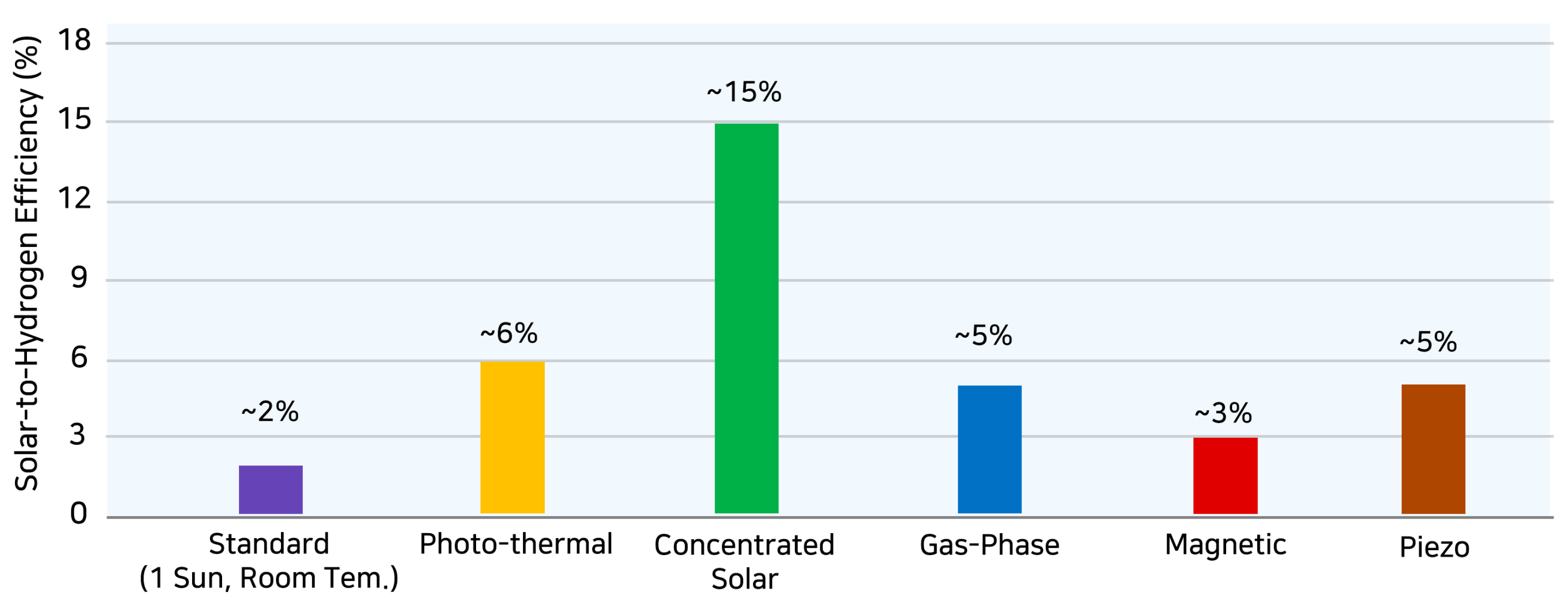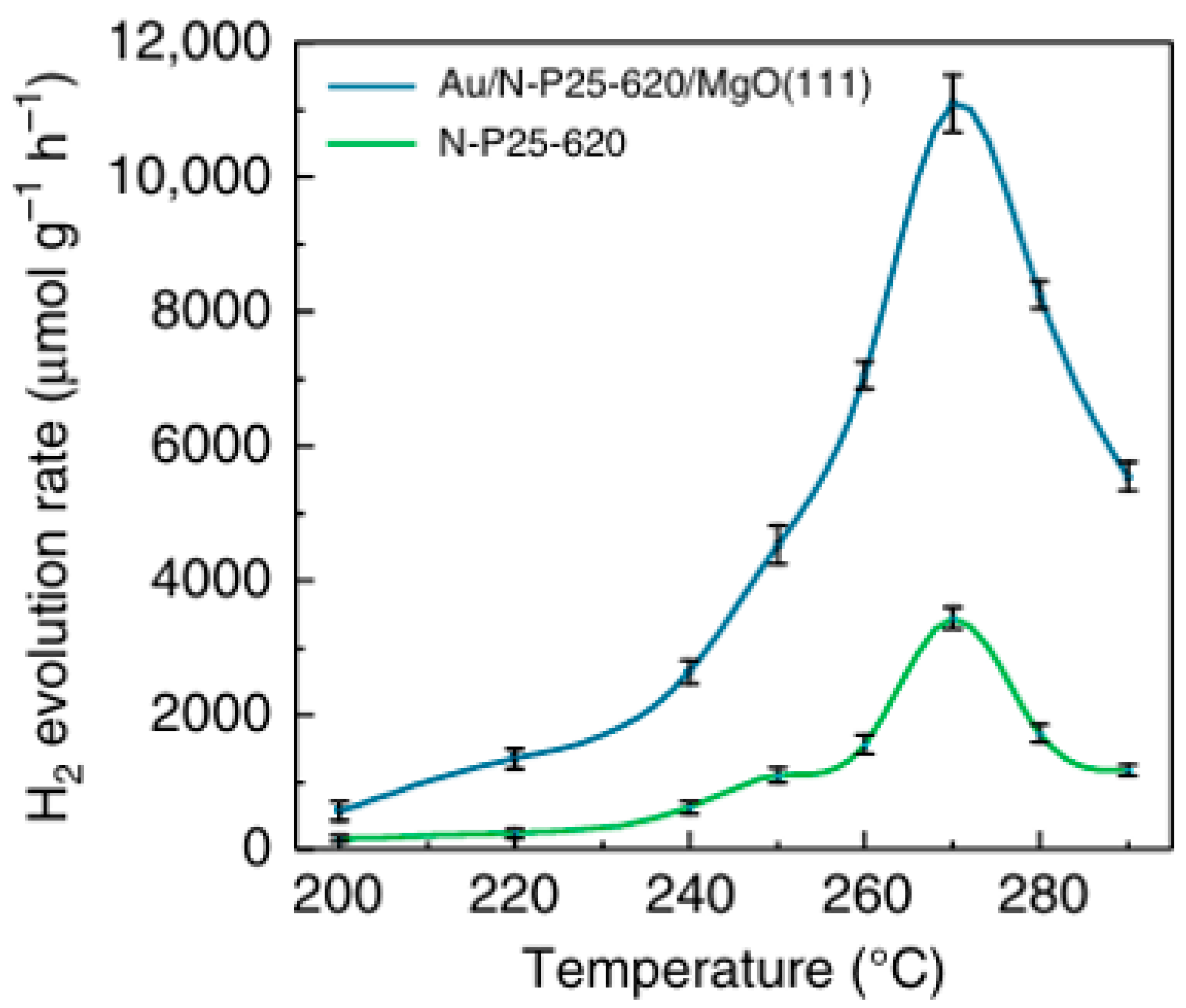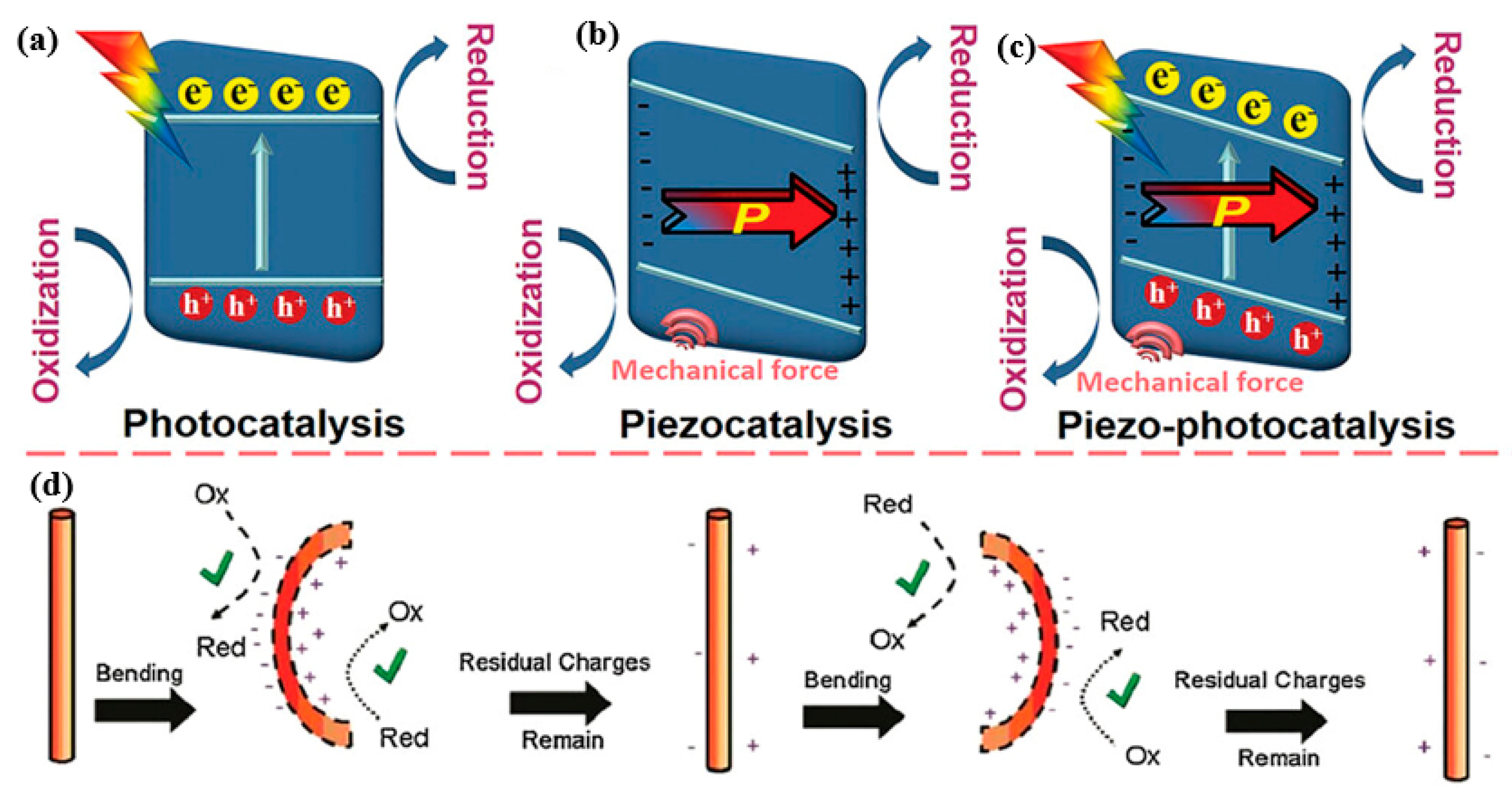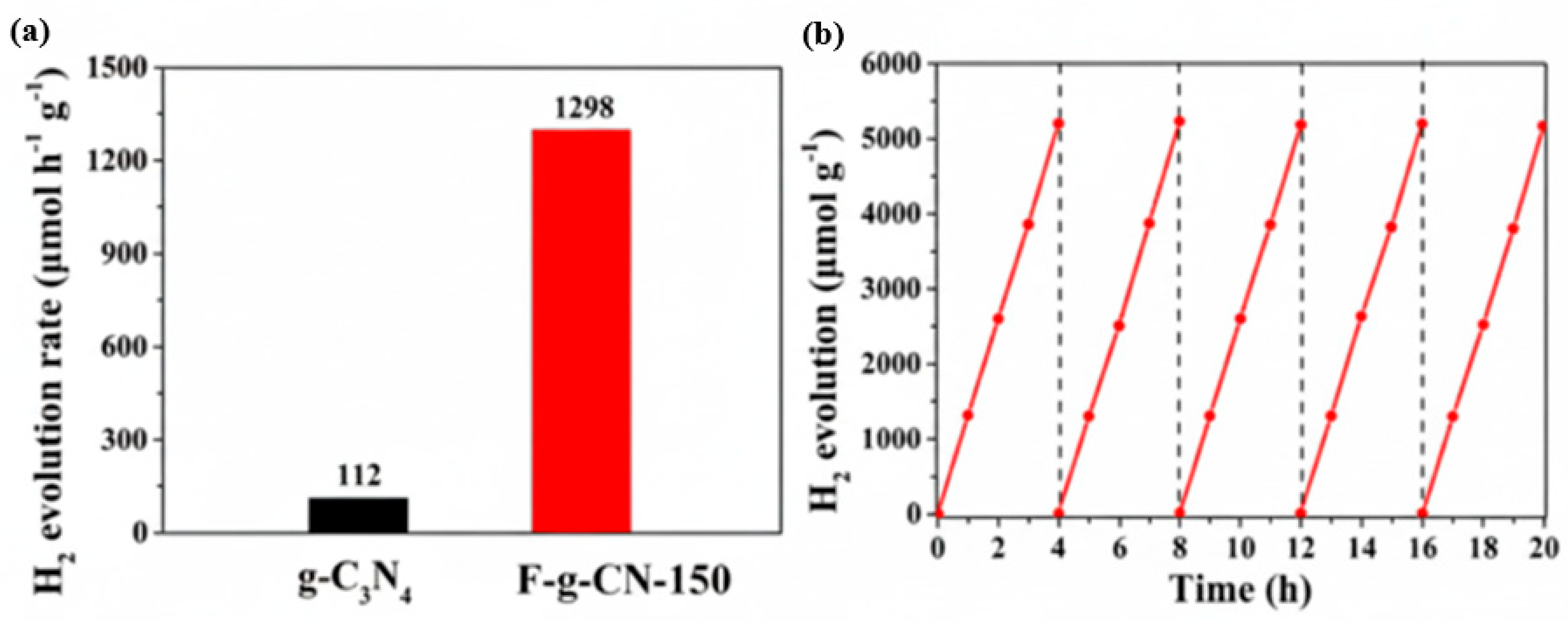1. Introduction
Since the pioneering report of water splitting on a TiO
2 electrode by Fujishima and Honda in 1972, photocatalysis has been extensively investigated for over five decades as a promising technology for converting abundant solar energy into valuable chemical energy [
1]. This field was born from the vision of mimicking natural photosynthesis to produce clean fuels, offering a sustainable alternative to fossil-fuel-based energy systems. Throughout this period, significant research efforts have led to notable advancements across various applications, from environmental remediation to organic synthesis [
2,
3]. The development and subsequent commercialization of materials like Degussa P25 (TiO
2) for applications such as self-cleaning surfaces and air purification stand as testaments to the practical utility of photocatalysis [
4]. However, despite these successes, the application of photocatalysis in highly competitive fields like large-scale hydrogen production has largely remained confined to academic research, failing to achieve significant commercial success.
The economic viability of energy technology is the ultimate measure of its practical application and its potential to contribute to the global energy transition. In the landscape of solar hydrogen production, the benchmark is currently set by systems combining commercial photovoltaic (PV) cells with water electrolyzers. With PV modules routinely exceeding 20% solar-to-electricity efficiency and modern electrolyzers operating at 60–70% electrical-to-hydrogen efficiency, this established pathway, which combines PV operating under standard illumination (e.g., AM 1.5G, 1 Sun) with electrolysis performing overall water splitting (typically without sacrificial agents), can achieve a solar-to-hydrogen (STH) conversion efficiency of 10–14% [
5]. This benchmark not only positions PV-electrolysis as a technologically mature and economically plausible route but also sets a high bar for emerging technologies to meet. In stark contrast, when measured under standard reporting conditions (i.e., 1 Sun illumination at room temperature), the STH efficiency of photocatalytic overall water splitting, for decades, has remained largely stagnant, typically hovered around a mere 1–2% until very recently [
5]. This profound efficiency gap has been the primary obstacle, highlighting the fundamental challenges that have historically hindered its industrial deployment and relegated it to a technology of future promise rather than present reality.
This fundamental stagnation in efficiency originates from an intrinsic and deeply rooted dilemma inherent to single-component semiconductor photocatalysts: the inescapable trade-off between light absorption and redox potential. To thermodynamically drive an overall reaction like water splitting (ΔG
0 = +237 kJ/mol), which requires a minimum energy input of 1.23 eV per electron, a conduction band minimum (CBM) and valence band maximum (VBM) of photocatalyst must straddle the hydrogen evolution reaction (HER, 0 V vs. NHE) and oxygen evolution reaction (OER, +1.23 V vs. NHE) potentials, respectively [
6]. This thermodynamic requirement typically requires a wide-bandgap semiconductor (e.g., TiO
2, E
g ≈ 3.2 eV) to provide sufficient driving force. However, a wide bandgap inevitably restricts light absorption to the ultraviolet (UV) region of the solar spectrum, which accounts for less than 5% of the total incoming solar energy [
2]. This severely limits the generation rate of charge carriers (electron–hole pairs), acting as a primary constraint on the overall quantum yield [
7]. Conversely, narrowing the bandgap to harvest a larger portion of the abundant visible and near-infrared spectrum (e.g., CdS or α-Fe
2O
3) enhances charge carrier generation but often results in insufficient redox potentials, where the photogenerated electrons are not energetic enough to reduce protons, or the holes lack the power to oxidize water [
8]. This persistent trade-off has been one of the primary scientific and engineering bottlenecks, intertwined with other critical factors such as rapid charge recombination, interfacial defects, and mass transport limitations, creating an “efficiency ceiling” that impeded progress for decades.
This review aims to illuminate recent key strategies that fundamentally circumvent these long-standing limitations and offer practical pathways to significantly enhance photocatalytic efficiency, pushing the field from incremental improvements to transformative advancements. We move beyond the traditional material-centric design philosophy and focus on three innovative and disruptive approaches that are shifting the existing paradigm and redefining the performance boundaries of photocatalysis.
Section 2 will examine the design and application of Z-scheme and S-scheme heterostructures, which are sophisticated architectures that mimic the charge transfer pathways of natural photosynthesis to resolve the bandgap dilemma. This strategy ingeniously spatially separates the reduction and oxidation half-reactions onto two distinct, coupled semiconductors—one optimized for strong reduction (photocatalyst I) and another for strong oxidation (photocatalyst II). By engineering the charge flow between them, the system can effectively utilize visible-light-responsive, narrow-bandgap materials to generate abundant charge carriers while simultaneously preserving the strong redox power of wide-bandgap materials, thus achieving the “best of both worlds.”
Section 3 will discuss a paradigm-shifting strategy: replacing the kinetically sluggish oxygen evolution reaction (OER) with value-added organic oxidation reactions. The multi-proton, four-electron OER is notoriously slow and often acts as the rate-determining step (RDS) for overall water splitting, creating a kinetic bottleneck. By strategically substituting it with thermodynamically more favorable and economically attractive reactions, such as the conversion of biomass-derived platform chemicals or the upcycling of plastic waste, this kinetic hurdle is effectively bypassed. This dual-function approach not only boosts hydrogen production rates but also co-produces valuable chemicals, thereby transforming the economic equation of the entire process from a simple fuel-generation system to a sustainable chemical refinery.
Section 4 will explore the often-underestimated impact of manipulating reaction conditions, particularly through the synergistic integration of photothermal effects, concentrated sunlight, and other external energy fields. While the intrinsic appeal of photocatalysis lies in its use of solar energy alone, the strategic integration of low-cost thermal energy, such as industrial waste heat, can dramatically improve reaction kinetics, charge transport, and overall quantum yields without compromising the green credentials. Recent landmark reports of STH efficiencies reaching double-digit percentages using concentrated sunlight and elevated temperatures highlight the immense, untapped potential of this holistic, system-level optimization approach.
Collectively, these emerging strategies represent the forefront of photocatalysis research. They provide a clear and compelling perspective on the key directions for overcoming its long-standing challenges, breaking through the historical efficiency ceiling, and paving the way for photocatalysis to finally realize its potential as a practical and impactful technology for a sustainable energy future as illustrated in
Figure 1.
2. Z-Scheme and S-Scheme Heterojunctions: Mimicking Nature to Overcome the Bandgap Dilemma
2.1. The Intrinsic Limitation of Single-Component Photocatalysts and the Imperative for Heterojunctions
The core process of photocatalysis begins when a semiconductor absorbs a photon with energy equal to or greater than its bandgap (Eg), creating an electron–hole pair. For this event to be productive in a demanding reaction like overall water splitting, the generated charge carriers must efficiently separate, migrate to the catalyst surface, and participate in redox reactions before recombination occurs, as shown in
Figure 2. However, in a single component photocatalyst, this cascade of events is governed by a fundamental conflict, as established in the introduction: the inherent trade-off between absorbing a wide spectrum of light and maintaining sufficient redox potential for the reaction. This core dilemma is compounded by a major kinetic hurdle. Even in mate-rials with thermodynamically suitable band edge positions, the efficiency is often plagued by the rapid recombination of photogenerated electrons and holes. This process, occurring on timescales from picoseconds to nanoseconds, represents a primary energy loss pathway and drastically reduces the overall quantum efficiency.
To overcome these intertwined limitations of poor light absorption, insufficient redox potential, and severe charge recombination, the construction of heterojunctions, which interfaces between two or more different semiconductor materials, has become an indispensable strategy. By judiciously pairing materials with complementary properties, heterojunctions offer a powerful platform to engineer the flow of charge carriers. This approach allows for the simultaneous enhancement of charge separation, extension of the light absorption range, and preservation of required redox potentials, creating synergistic effects that can exceed the performance of individual components.
2.2. The Z-Scheme Heterostructure: A Bio-Inspired Solution
The design of Z-scheme photocatalytic systems draws inspiration from natural photosynthesis in green plants, which effectively promotes charge separation and directional electron transfer. Photosynthesis utilizes two distinct photosystems (Photosystem I and Photosystem II) connected in series, which creates a Z-shaped energy diagram for electron flow as depicted in
Figure 3a [
10]. Photosystem II (PS II) uses light to generate highly oxidizing holes capable of splitting water, while Photosystem I (PS I) uses light to produce highly reducing electrons. The less energetic electrons from PS II are subsequently transferred to PS I through a series of electron mediators, replenishing those lost by PS I. This sophisticated architecture enables nature to use two lower-energy photons for a reaction that would otherwise require a single, much higher-energy photon, thereby allowing the use of the broad visible spectrum.
Inspired by this natural process, the initial strategy to overcome the drawbacks of single materials involved creating junctions between two different semiconductors, leading to the development of the conventional Type-II heterojunction. While this design improved charge separation, it came with a critical flaw: both electrons and holes migrate to the semiconductor with the narrower bandgap, funneling them into positions of weaker redox potential. As a result, while useful for certain applications, the Type-II configuration is generally ineffective for overall water splitting, a reaction that requires powerful redox capabilities [
11].
To address the inherent limitations of the Type-II system, the artificial Z-scheme was developed to more accurately replicate the charge-flow mechanism of photosynthesis. This system pairs a semiconductor with strong oxidation power (PC II, an O
2-evolution photocatalyst) with one possessing strong reduction power (PC I, a H
2-evolution photocatalyst). A key step involves the engineered recombination of electrons from the conduction band (CB) of PC II with holes from the valence band (VB) of PC I at their interface. This process selectively eliminates the “useless” charge carriers possessing weak redox potentials. Consequently, highly reducing electrons are preserved in the CB of PC I, and highly oxidizing holes accumulate in the VB of PC II, as shown in
Figure 3b. This mechanism achieves the dual goals of maintaining strong redox power and enabling efficient charge separation, allowing the system to drive both half-reactions with high efficiency [
12,
13].
Historically, the first Z-schemes were realized with a liquid-phase redox mediator (e.g., the I
−/IO
3− couple) to transport electrons from PC II to PC I [
14]. Although the concept was experimentally validated, the method suffered from side reactions and light-shielding effects. This led to the creation of all-solid-state Z-schemes, which employ a solid conductor such as a noble metal or graphene as the electron mediator. These systems, however, can be difficult to fabricate precisely and may suffer from the formation of Schottky barriers that obstruct charge flow [
13,
14]. The most recent and promising development is the direct Z-scheme, in which two semiconductors are placed in intimate contact without any mediating material [
15]. Here, charge transfer is governed by an internal electric field at the interface, a concept foundational to the S-scheme discussed next.
2.3. The S-Scheme Heterojunction: A Refined Charge Transfer Pathway
While the direct Z-scheme represented a significant advancement, precise control of interfacial charge recombination remained a challenge. Unwanted charge transfer pathways could still compete with the desired Z-scheme pathway [
16]. Specifically, the band alignment of a given semiconductor pair can often theoretically satisfy the conditions for both Type-II and direct Z-scheme heterojunctions, creating ambiguity in the charge transfer pathway at the interface. Although the intended Z-scheme pathway (recombination of weak electrons from PC II with weak holes from PC I) can occur, the competing Type-II pathway (migration of powerful electrons from PC I to PC II, or powerful holes from PC II to PC I) is also physically plausible, potentially weakening the final redox potential of the charge carriers. Therefore, possessing a suitable band alignment alone is insufficient; a clear driving force is essential to selectively promote the desired Z-scheme pathway while suppressing competing Type-II migration.
To address this ambiguity and provide a more physically robust model, the step-scheme (S-scheme) heterojunction was proposed. The S-scheme pairs a reduction photocatalyst (PC I) with an oxidation photocatalyst (PC II), where the Fermi level of PC I is higher than that of PC II, and both the CB and VB of PC I are positioned at higher energy levels than those of PC II. Upon contact, electrons flow from PC I to PC II until their Fermi levels align, leading to the formation of an electron depletion layer in PC I and an electron accumulation layer in PC II. This charge redistribution creates a strong internal electric field directed from PC I to PC II and causes upward band bending in PC I and downward band bending in PC II (See
Figure 4) [
14].
Under light irradiation, this built-in electric field governs charge migration. Photogenerated electrons in the CB of PC II (weaker reducing power) and holes in the VB of PC I (weaker oxidizing power) are driven towards the interface by this field, where they readily recombine. Simultaneously, the powerful electrons in the CB of PC I and the powerful holes in the VB of PC II are effectively repelled from the interface by the band bending and accumulate on their respective surfaces, preserving the strongest possible redox potentials.
Compared to the direct Z-scheme, the S-scheme offers a more definitive mechanism for charge separation, driven by an active, field-induced process rather than passive recombination. This eliminates the need for external mediators, avoids light-shielding effects, and provides a clearer pathway for maximizing the spatial separation of useful charge carriers. As shown in
Figure 5, the S-scheme concept can be realized across various semiconductor junction types (n-n, p-p, n-p, p-n), offering flexibility in material selection and representing a promising heterojunction concept in modern photocatalysis [
17].
2.4. Recent Breakthroughs in Z-Scheme and S-Scheme Heterojunctions
The conceptual power of Z- and S-schemes has fueled an explosion of research, leading to notable advancements in photocatalytic hydrogen production. As shown in
Figure 6 and
Table 1, recent break-throughs have moved beyond simple material combinations and are now focusing on sophisticated strategies involving novel materials, elemental doping, defect engineering, and precise interfacial control to maximize performance
This section may be divided by subheadings. It should provide a concise and precise description of the experimental results, their interpretation, as well as the experimental conclusions that can be drawn.
2.4.1. Elemental Doping and Novel Material Integration: Expanding the Absorption Frontier
A primary strategy for enhancing heterojunction performance is to fundamentally improve the properties of the constituent materials themselves. By introducing dopants or integrating novel materials with unique electronic and optical properties, researchers can extend light absorption into the visible spectrum and create more favorable band alignments, directly addressing the core limitations of traditional wide-bandgap semiconductors.
A compelling example of this approach was demonstrated by Madiha et al., who constructed a direct Z-scheme from Al-doped SrTiO
3 and g-C
3N
4 nanosheets. While SrTiO
3 is a classic photocatalyst for overall water splitting, its wide bandgap limits its activity to UV light. The key innovation in this work was the introduction of aluminum (Al) doping into the SrTiO
3 lattice, which created defect states that successfully extended its light absorption into the visible region. This modified oxide was then coupled with g-C
3N
4, a stable polymer photocatalyst with a suitable band structure for hydrogen evolution. The resulting heterojunction, further optimized with Rh/Cr/Co co-catalysts, achieved an exceptional hydrogen production rate of 15,900 μmol g
−1 h
−1 with an external quantum efficiency (EQE) of 14% at 365 nm. This work exemplifies how modifying traditional materials through doping and pairing them with complementary partners can unlock unprecedented activity [
20].
Similarly, the integration of emerging 2D materials offers a powerful route to sensitize traditional photocatalysts. Zhou et al. paired black phosphorus (BP), a 2D material known for its excellent visible light absorption and high carrier mobility (≈1000 cm
2V
−1s
−1), with classic TiO
2. In this Z-scheme, the narrow-bandgap BP effectively acts as a visible-light antenna, generating charge carriers that then follow the Z-scheme pathway to leverage the favorable band positions of the stable, wide-bandgap TiO
2. This strategic pairing yielded a H
2 production rate of 139.5 μmol g
−1 h
−1 under visible light (λ ≥ 400 nm), a 4.73-fold enhancement compared to bare BP, effectively overcoming the primary limitation of TiO
2-based systems [
21]. Further refinement of this strategy was shown by He et al., who combined Cu-doping of ZnIn
2S
4 with the creation of oxygen vacancies (V
o) in TiO
2. The Cu-doping enhanced light absorption, while the oxygen vacancies in TiO
2 provided more active sites, leading to a synergistic Z-scheme with a H
2 evolution rate of 589.64 μmol g
−1 h
−1 [
22].
2.4.2. Atomic-Level Interfacial Engineering
The performance of a heterojunction is critically dependent on the quality of its interface, as this is where charge transfer occurs. Imperfect interfaces with physical gaps, defects, or amorphous layers can act as powerful recombination centers, revoking the benefits of the hetero-structure. Therefore, designing synthesis methods that create clean, atomically precise, and strongly coupled interfaces is a crucial frontier for maximizing efficiency. By minimizing interfacial defects, charge carriers can transfer smoothly and efficiently along the desired Z-scheme or S-scheme pathway, rather than being lost to parasitic re-combination events.
A landmark study by Zhang et al. showcased the profound impact of atomic-level control in an S-scheme system. They developed a precise sonochemical strategy for the epitaxial growth of CdS nanoparticles (the OP) onto the (007) crystal facet of ZnIn
2S
4 nanosheets (the RP). This method resulted in a nearly seamless interface with a lattice mismatch of less than 5%. This atomically perfect junction dramatically minimized defects and created an optimal, unobstructed pathway for the S-scheme charge transfer. The result was a hydrogen production rate of 5678 μmol g
−1 h
−1 using Na
2SO
3 as a scavenger, a tenfold increase over pristine ZnIn
2S
4. This research provides definitive proof that moving beyond simple physical mixtures to sophisticated, atomically precise interfacial engineering is critical for maximizing performance [
18].
Another powerful strategy for creating high-quality interfaces is to leverage chemical and electrostatic forces. Entian Cui et al. designed an S-scheme heterojunction by combining two engineered carbon nitrides: a B-doped, N-deficient C
3N
4 (BN-C
3N
4) as the OP and an O-doped C
3N
5 as the RP [
23]. Critically, these materials were designed to have opposite zeta potentials (BN-C
3N
4: −24.7 mV; O-C
3N
5: +21.1 mV), allowing them to self-assemble via electrostatic attraction. This process was further enhanced by the formation of interfacial B-O chemical bonds, creating an intimately bonded interface far superior to one held by weak van der Waals forces. After loading with Pt and Co(OH)
2 co-catalysts, this so-phisticated design yielded a H
2 production rate of 802.4 μmol g
−1 h
−1 and a high apparent quantum yield (AQY) of 10.9% at 420 nm.
2.4.3. Synergistic Coupling with Other Phenomena
A truly innovative frontier in heterojunction design involves creating multifunctional systems that couple photocatalysis with other physical phenomena, such as piezoelectricity. This strategy aims to use an external energy input, like mechanical vibration, to generate an in-ternal electric field that provides an additional, powerful driving force for charge separation, working in synergy with the built-in field of the heterojunction.
Yang et al. demonstrated this principle with a Z-scheme composed of Bi
2Fe
4O
9 and ZnIn
2S
4. The key innovation was the use of the piezoelectric properties of Bi
2Fe
4O
9. When the system was subjected to ultra-sonic vibration, the Bi
2Fe
4O
9 generated an internal electric field that powerfully assisted in separating the photogenerated charges and driving them along the Z-scheme pathway. This dual-stimulus approach, combining photons with phonons, resulted in a very high hydrogen production rate of 1862 μmol g
−1 h
−1 [
24]. Similarly, Mumtaz et al. designed a hybrid piezo-photocatalyst using a Bi
0.5Na
0.5TiO
3 perovskite matrix reinforced with RGO-Co
3O
4. Under combined illumination and ultrasonication, the piezoelectric field generated by the perovskite enhanced the Z-scheme charge separation at the RGO-Co
3O
4 interface, yielding a H
2 evolution rate of 109 μmol g
−1 h
−1. These studies showcase a novel and highly effective strategy for enhancing charge separation beyond what is possible with the heterojunction alone, opening a new direction for multifunctional catalyst design [
25]. Another example by Haroonabadi et al. showed that combining two perovskites, 70% BiFeO
3 and 30% BaTiO
3, created a unique n-n heterojunction. The piezoelectric nature of the BaTiO
3 component likely contributed to the enhanced charge separation, leading to a H
2 production of 328 μmol g
−1 h
−1 [
26].
Table 1.
Recent research on Z/S-scheme Photocatalyst System: H2 Production (μmol g−1 h−1), Quantum Yield (%), Light source, Scavenger.
Table 1.
Recent research on Z/S-scheme Photocatalyst System: H2 Production (μmol g−1 h−1), Quantum Yield (%), Light source, Scavenger.
| Photocatalyst System | Photocatalysts | H2 Production (μmol g−1 h−1) | Quantum Yield (%) | Light Source | Scavenger | Ref. |
|---|
| Direct Z-scheme | Black phosphorus, TiO2 | 139.5 μmol g−1 h−1 | 1.09% | 300 W Xenon lamp with visible light filter () | - | [21] |
| Direct Z-scheme | Al-SrTiO3, g-C3N4 | 15,900 μmol g−1 h−1 | 14% (EQE) | 300 W Xenon lamp, LED UV light | - | [20] |
| S-scheme | CdS, ZnIn2S4 | 5678 μmol g−1 h−1 | 6.1% | 300 W Xenon lamp with filter () | Na2SO3,Na2S | [18] |
| S-scheme | BN-C3N4, O-C3N5 | 802.4 μmol g−1 h−1 | - | 300 W Xenon lamp with visible light filter () | - | [23] |
| Direct Z-scheme | Cu-ZnIn2S4/TiO2(Vo) | 589.64 μmol g−1 h−1 | 1.93% | 300 W Xenon lamp with visible light filter () | - | [22] |
| S-scheme | CuO/porous g-C3N4 | 30 μmol g−1 h−1 | 1.67% | 400 W Xenon lamp with visible light filter () | TEOA | [27] |
| Z-scheme | Bi0.5Na0.5TiO3/RGO-Co3O4 | 109 μmol g−1 h−1 | - | 400 W/645 E40 neutral
stable white on multi-gear bulb | - | [25] |
| Direct Z-scheme | Bi2Fe4O9-ZnIn2S4 | 1862 μmol g−1 h−1 | 1.55% | Solar () | - | [24] |
| Direct Z-scheme | 70 BiFeO3−30 BaTiO3 | 328 μmol g−1 h−1 | - | 125 W Hg lamp (×3) | - | [26] |
2.5. Challenges and Outlook: The Path Toward Practical Application
Despite the notable progress and efficiencies demonstrated by Z- and S-scheme systems, the transition from promising laboratory-scale concepts to viable industrial technologies remains constrained by several significant hurdles. The impressive performance metrics reported often mask underlying complexities related to mechanism, synthesis, and long-term viability. A critical perspective is necessary to guide future research toward addressing these bottlenecks.
2.5.1. Definitive Elucidation of the Charge Transfer Mechanism
Perhaps the most pressing issue in the field is the often ambiguous and sometimes unsubstantiated claims of the operating mechanism. As shown in
Figure 7, the band alignments for a Type-II and a direct Z/S-scheme can appear similar, and simply observing enhanced photocatalytic activity is insufficient proof of a specific pathway. A compelling illustration of this challenge is found in extensively studied systems like anatase/rutile TiO
2 composites or TiO
2/g-C
3N
4 heterojunctions (
Figure 8) [
28,
29,
30,
31]. Due to the inherent similarities in their band alignments, these exact same material pairs have, in different studies, been convincingly argued to operate under either a Type-II or a Z-scheme framework. This discrepancy often arises not from flawed analysis, but from the immense technical difficulty in definitively measuring the real-time charge dynamics at a buried solid–solid interface. Observing enhanced photocatalytic activity alone is insufficient proof, as both mechanisms can theoretically lead to improved charge separation. This ambiguity is a serious problem; it can lead to the misinterpretation of results and guide the community down incorrect research paths.
To ensure credibility and progress, researchers should employ advanced in situ characterization techniques to definitively prove the charge transfer pathway. Time-Resolved Photoluminescence (TRPL) spectroscopy, which measures the decay lifetime of photogenerated charge carriers, provides direct evidence of whether an efficient charge separation pathway exists as shown in
Figure 9a [
32]. A significantly shorter lifetime in the heterojunction compared to its components indicates efficient charge separation. Furthermore, techniques like Surface Photovoltage (SPV) spectroscopy can determine the direction of charge separation by measuring changes in surface potential upon illumination, providing crucial data to distinguish between Z-scheme and Type-II pathways (
Figure 9b) [
33,
34]. Widespread adoption of these and other advanced techniques (e.g., transient absorption spectroscopy, Kelvin probe force microscopy) should become a standard requirement for claiming a specific heterojunction mechanism.
2.5.2. The Critical Role of Fabrication in Realizing Performance
The ultimate goal is to develop technologies that operate reliably and economically on a large scale. Achieving this, however, depends not only on the intrinsic properties of the catalyst but also on the fabrication method, a factor whose profound impact on performance has been comparatively underestimated. Unlike single-component systems, the efficiency of Z-scheme and S-scheme heterojunctions depends critically on interface quality and overall morphology. Therefore, how these complex structures are assembled is just as important as the intrinsic properties of the materials themselves.
A stark demonstration comes from the work of Wang et al., showing that the fabrication method can cause a tenfold difference in performance. A Z-scheme system achieving 1% STH efficiency as a powder exhibited only 0.1% STH when prepared as a film, attributed to differences in surface area, defect density, and charge transport pathways [
35]. This finding highlights a crucial point: even a photocatalyst with ideal material properties can fail to deliver its potential if the fabrication process is not precisely controlled. As material development approaches theoretical limits, the importance of fabrication and device engineering will become more prominent. Future research must focus not only on discovering new materials but also on developing scalable, cost-effective, and reproducible synthesis and fabrication methods to translate the potential of complex nanostructures into high-efficiency devices.
2.5.3. The Final Hurdle: Bridging the Gap Between Theoretical Promise and Experimental Reality
A clear challenge is that while Z-scheme and S-scheme concepts are theoretically sound, experimentally achieved efficiencies have generally not yet reached levels competitive with established technologies like PV-electrolysis. This difficulty is reflected in the literature; despite abundant publications on Z- and S-schemes, reports presenting clear and high STH efficiencies remain exceptionally few, highlighting the challenge of translating theoretical advantages into practical performance. Computational studies, often employing ideal models with atomically perfect interfaces and defect-free crystals, provide invaluable in-sights and tantalizing predictions, with some theoretical STH efficiencies exceeding 20% or even 40% (
Table 2) [
36]. These theoretical analyses are not mere fantasies; they illuminate the immense untapped potential of these heterostructures and offer crucial guidance for the rational design of next-generation materials.
However, a persistent gap remains, as real-world experimental values are often significantly lower than these predictions. This discrepancy arises from challenges in practical synthesis, where factors like poor physical contact, amorphous interfacial layers, point defects, and surface contamination can act as recombination centers, drastically reducing quantum efficiency.
To bridge this gap and unlock the theoretically possible performance, the field must intensify its focus on precise synthesis and advanced interfacial engineering. Realizing the full potential of Z-scheme and S-scheme systems requires moving beyond conventional methods. For powder-based catalysts, this includes sophisticated colloidal synthesis techniques such as controlled surface deposition, selective chemical etching, and in situ growth of co-catalysts to create intimate and defect-free interfaces. For model systems and thin-film applications, advanced techniques like atomic layer deposition (ALD) remain crucial for fundamental studies. Ultimately, these strategies are essential for creating the high-quality interfaces needed to turn theoretical promise into experimental reality.
3. Replacing Oxygen Evolution Reaction with Value-Added Organic Synthesis: A Paradigm Shift in Photo-Catalytic Economics
3.1. OER as the Fundamental Bottleneck in Overall Water Splitting
Photocatalytic water splitting systems consist of two half-reactions: the hydrogen evolution reaction (HER) and the oxygen evolution reaction (OER). While H2 production occurs through the reduction in protons by photogenerated electrons (e−), the corresponding oxidation holes (h+) must be consumed in the OER. Of these, the OER, involving the release of oxygen from water, has a complex reaction pathway involving the sequential transfer of four electrons and four protons. Due to this intrinsic complexity, the OER is notoriously sluggish and almost universally recognized as the rate-determining step (RDS) for the entire water splitting process.
The role of OER as the primary bottleneck stems from several deeply rooted factors. First is its complex, multi-step reaction mechanism. According to the widely accepted Adsorbate Evolution Mechanism (AEM), OER proceeds through several adsorbed intermediates (e.g., *OH, *O, *OOH), each step involving electron-proton coupled transfers with distinct activation barriers. [
41,
42] The strong adsorption of these intermediates on the catalyst surface can significantly slow the reaction kinetics, thereby limiting the overall rate of water splitting. Second, a “scaling relationship” between the adsorption energies of key intermediates like *OH and *O imposes a fundamental limit on catalyst efficiency. This linear correlation means that strengthening the bond to one intermediate inevitably weakens the bond to another, creating a trade-off that prevents the simultaneous optimization of all elementary steps. This dilemma results in a theoretical minimum overpotential of approximately 370 mV that even an ideal catalyst cannot overcome [
43]. Third, OER necessitates a high overpotential in practice. While the thermodynamic potential for OER is +1.23 V (vs. RHE), real-world systems require significantly higher potentials to overcome resistances at the catalyst-electrolyte interface, the energy cost of intermediate adsorption/desorption, and charge transfer limitations [
44]. This excess energy input, or overpotential, is a primary source of efficiency loss in the system [
45].
These fundamental kinetic limitations of OER, initially investigated extensively in electrocatalysis, are even more pronounced in photocatalysis, where charge carriers are generated by light and cannot be supplemented by an external bias to overcome such a large overpotential [
46,
47]. Consequently, these challenges are even more pronounced and act as a more severe bottleneck. Beyond these kinetic and thermodynamic challenges, the OER process presents significant practical and economic drawbacks. The product, oxygen (O
2), not only has low economic value but also introduces safety hazards. While gas crossover is a known safety issue in electrolyzers, this challenge is inherent to photocatalysis, where H
2 and O
2 are always produced as a mixture, posing significant safety risks and separation challenges. Furthermore, reactive oxygen species (ROS) such as •OH and H
2O
2, formed as intermediates, are highly oxidizing and can induce structural degradation of the catalyst surface, compromising long-term durability [
48]. Confronted with these challenges, a paradigm-shifting strategy has emerged: replacing the OER bottleneck entirely with thermodynamically and kinetically favorable value-added organic reactions (VAORs) [
49,
50].
3.2. From Sacrificial Agents to Value-Added Synthesis: A Conceptual Evolution
The concept of using an organic compound to facilitate photo-catalytic hydrogen production is not new. For decades, “sacrificial agents” such as methanol, triethanolamine (TEOA), and EDTA have been widely used in laboratory studies. These compounds act as highly efficient hole scavengers, readily donating electrons to the photogenerated holes in the valence band [
51]. By rapidly consuming the holes, they effectively suppress electron–hole recombination, thereby dramatically increasing the rate of hydrogen evolution. While this method is invaluable for evaluating the intrinsic HER activity of a new photo-catalyst, it is fundamentally unsustainable and economically unviable for large-scale application [
52]. The sacrificial agent is irreversibly consumed, and its oxidation products are typically low-value or even undesirable waste streams. In essence, this approach “sacrifices” a chemical to produce hydrogen.
Value-Added Organic Reactions (VAORs) represent a completely different philosophy. Instead of consumption of traditional sacrificial agents, this strategy aims to upgrade it [
53]. The photogenerated holes are used to drive the highly selective oxidation of a low-value organic substrate into a high-value, marketable chemical product. The key difference lies in the selectivity and economic value of the oxidation product. For example, as shown in
Figure 10, instead of fully oxidizing methanol to CO
2, a VAOR system might selectively oxidize benzyl alcohol to benzaldehyde, a valuable fragrance and chemical intermediate. This transforms the anodic half-reaction from a costly waste-generating process into a profitable chemical synthesis process [
54,
55,
56].
This approach creates a powerful economic synergy. The revenue generated from the sale of the co-produced chemical can significantly offset, or even exceed, the operational costs of hydrogen production, fundamentally altering the economic feasibility of the entire system. Furthermore, this strategy aligns perfectly with the principles of a circular economy, enabling the use of renewable feedstocks, such as bio-mass-derived platform chemicals or even plastic waste, to produce both green hydrogen and green chemicals.
3.3. Thermodynamic and Kinetic Advantages of VAORs
The strategic replacement of OER with VAORs is underpinned by significant thermodynamic and kinetic advantages. Kinetically, OER is a four-electron transfer (4e−) process that serves as the primary bottleneck due to its high overpotential and multistep pathway. The standard ox-idation potential of OER is 1.23 V vs. RHE, but in practice, a driving voltage of 1.6–1.8 V or higher is often required due to the activation energy barriers and surface adsorption of intermediates (*OH, *O, *OOH). This severely lowers the energy efficiency and deteriorates the long-term stability of the system.
In contrast, VAORs can proceed at much lower thermodynamic oxidation potentials. For example, the oxidation potential of benzyl alcohol (BzOH) is approximately 0.6–0.8 V vs. RHE, [
57] and that of 5-hydroxymethylfurfural (HMF) is ~0.5 V vs. RHE, meaning the reaction can be initiated at a potential 0.4–0.7 V lower than that of OER [
58,
59]. This lower potential allows holes to be consumed more readily, which suppresses charge accumulation and enhances the corresponding HER efficiency. This not only improves the overall system efficiency by more readily consuming photogenerated holes, thereby suppressing charge recombination and increasing the quantum yield, but also enhances catalyst stability by mitigating corrosion and ROS generation.
From a kinetic perspective, the advantages are equally compelling. Most organic oxidation reactions proceed primarily through a simpler two-electron transfer process, resulting in a lower activation energy (typically 0.2–0.6 eV) [
60]. This pathway is far simpler than the four-electron, multi-intermediate mechanism of OER. Consequently, charge transfer is faster, and charge recombination losses are mini-mized [
53,
61]. For example, as demonstrated in electrocatalytic studies which provide insight into the inherent kinetics, the coupled oxidation of benzyl alcohol with hydrogen evolution has been shown to achieve a high current density of 540 mA cm
−2 at 1.5 V vs. RHE, demonstrating far superior performance at lower voltages compared to OER. Furthermore, because VAORs do not generate O
2, they fundamentally avoid the safety risks associated with gas crossover and ROS formation [
62]. In summary, VAORs offer a compelling alternative route with lower operating voltages, faster reaction rates, and higher charge utilization efficiency, all while providing superior safety and economic feasibility.
3.4. Breakthroughs in Coupled Hydrogen Production and Value-Added Synthesis
Replacing the sluggish oxygen evolution reaction (OER) with value-added oxidation reactions has emerged as a transformative paradigm in photocatalytic hydrogen production. Over the past five years, intensive research efforts have focused on coupling solar-driven oxidation of organic substrates with hydrogen evolution, simultaneously enhancing kinetic efficiency and generating high-value products. Four representative categories, biomass upgrading, alcohol oxidation, plastic upcycling, and nitrogen fixation, illustrate the breadth of this emerging field.
3.4.1. Biomass Upgrading
Biomass-derived feedstocks such as 5-hydroxymethylfurfural (HMF) and furfural have become benchmark substrates for value-added oxidation because their redox potentials (0.5–1.0 V vs. RHE) are far lower than that of OER (1.23 V), and their oxidation prod-ucts—2,5-diformylfuran (DFF) and 2,5-furandicarboxylic acid (FDCA)—serve as key intermediates in bioplastic production. This dual advantage makes biomass upgrading both thermodynamically favorable and industrially relevant.
As shown in
Figure 11a, Bao et al. designed ultrathin g-C
3N
4 nanosheets capable of forming N–H-specific hydrogen bonds with HMF, leading to a reduction in activation energy for O–H and α-C–H bond cleavage. This surface-specific interaction enhances dehydrogenation kinetics, achieving ≈ 95% DFF selectivity under visible light. In parallel, heterojunction systems such as α-Fe
2O
3/Zn
0.5Cd
0.5S exemplify how band alignment and Z-scheme electron flow can simultaneously preserve oxidation strength and visible-light responsiveness without using noble metals [
63]. In parallel, Want et al. synthesized a Z-scheme heterojunction catalyst (α-Fe
2O
3/Zn
0.5Cd
0.5S) that operates efficiently without noble metals as in
Figure 11b. The optimal composition of 15% Fe
2O
3/Zn
0.5Cd
0.5S was the best, and in Ar atmosphere, the •OH (water-source)-centered pathway dominated, achieving 99% selectivity for DFF and 75% conversion (24 h), while in air atmosphere, the •O
2−/
1O
2 pathway was involved, achieving 85% selectivity for FDCA and 99% conversion (32 h). The reaction proceeds under a 413 nm LED (12 W), 20 mg catalyst, and aqueous solution, and is also operated under sunlight and showed stability in a 5-cycle reuse test [
64].
Beyond catalyst structure, reaction microenvironments have recently emerged as a decisive factor. Xue et al. in
Figure 11c. demonstrated that trace amounts of water in aprotic solvents can reorganize interfacial hydrogen-bonding networks, thereby accelerate selective oxidation and suppressing undesired peroxide accumulation. This subtle yet powerful insight—treating solvent molecules as active co-catalysts represents a conceptual advancement in photocatalytic re-action design [
65]. Collectively, these studies demonstrate that biomass upgrading reactions not only exhibit lower thermodynamic barriers but also generate value-added products (e.g., FDCA) essential for bioplastic synthesis, thus integrating energy and carbon valorization.
3.4.2. Alcohol Oxidation
Alcohol oxidation is another prototypical VAOR because it proceeds via a two-electron mechanism, requiring far less overpotential than OER, and yields valuable aldehyde or acid products [
66].
Chen et al. introduced a “nanoreactor” system based on Cu-doped ZnIn
2S
4 nanosheets coupled with Ni (II)-functionalized carbon dots (
Figure 12a). The internal electric field (IEF) formed at their interface enhanced charge and proton transfer, achieving simultaneous oxidation of benzyl alcohol (BA) and H
2 evolution with high selectivity. The system delivered H
2 and benzaldehyde at rates of 45.95 and 46.47 mmol g
−1 h
−1, respectively, nearly 37× higher than pristine ZnIn
2S
4, and reached an apparent quantum efficiency (AQE) of 40% at 420 nm [
67]. Li et al. further developed a direct Z-scheme heterojunction (WO
3/ZnIn
2S
4) where 2D ZnIn
2S
4 nanosheets coat 1D WO
3 nanorods. Under visible light, spatial charge separation drove BA oxidation (conversion ≈ 92%) and H
2 generation (214 μmol in 5 h) with 94.8% benzaldehyde selectivity and 1.74% AQY under 400 nm monochromatic light. This architecture demonstrated stable performance over four reuse cycles and broad substrate tolerance across substituted aromatic alcohols [
68].
Figure 12c shows that Romito et al. proposed a dye-sensitized photocatalyst that achieves visible-light-driven alcohol oxidation without traditional sacrificial electron donors. Here, the dye absorbs light, transfers electrons to the semiconductor for HER, and leaves behind holes that oxidize alcohols to aldehydes. The system achieved high selectivity across multiple alcohols (benzyl, furfuryl, allyl) without TEOA or other electron donors, underscoring the potential for clean, direct solar oxidation processes [
69]. Finally, Li et al. demonstrated that ZnIn
2S
4/Nix–B heterostructures can outperform noble-metal catalysts (See
Figure 12d). Amorphous Ni–B co-catalyst layers, grown in situ on ultrathin ZnIn
2S
4 nanosheets, enhanced charge separation and surface redox kinetics. The composite achieved an H
2 generation rate of 8.9 mmol h
−1 g
−1, 22 times that of ZnIn
2S
4 alone, and 96% selectivity for benzaldehyde oxidation, with an AQY of 24% at 420 nm [
70].
These studies reveal that two-electron alcohol oxidation is an efficient hole-consuming reaction, effectively suppressing charge recombination and enabling faster proton reduction The combination of advances in structural engineering, interface modulation, and designs avoiding traditional sacrificial agents now positions alcohol oxidation as one of the most scalable and mechanistically clear VAOR pathways.
3.4.3. Plastic Upcycling
Plastic waste reforming through photocatalysis represents an emerging synergy between waste valorization and renewable hydrogen generation. Unlike thermal depolymerization, which requires extreme temperatures and often produces toxic byproducts, photocatalytic up-cycling can selectively oxidize polymers under mild and environmentally benign conditions.
As provided in
Figure 13a, Lin et al. reported a tandem system employing hierarchical carbon nitride (FeSA-hCN) doped with single-atom Fe–N
4 sites. Under neutral conditions, the Fe centers activate H
2O
2 to drive oxidative depolymerization of microplastics such as UHMWPE into oxidized organics (C
2–C
20 range) and carboxylic acids with 64% selectivity. Over 90% degradation was achieved at 140–160 °C, with negligible Fe leaching (<0.1 ppm). The resulting organic acids were directly reused as feedstock in HER, producing hydrogen at 42 μmol h
−1—demonstrating a closed-loop photo-reforming system where waste oxidation powers H
2 evolution [
71]. And Kang et al. advanced this concept by using a MoS
2/g-C
3N
4 heterocatalyst to upcycle PET-derived ethylene glycol (EG) under sunlight shown in
Figure 13b. The heterojunction improved visible light absorption and charge separation, enabling EG oxidation to formic acid, acetate, CH
4, and H
2. Intriguingly, the product distribution was concentration-dependent: low EG concentrations (≈8 mM) favored acetic acid formation via methyl radicals, while high concentrations (≈300 mM) promoted formic acid production. This tunable selectivity highlights the potential of feed-dependent valorization, converting plastic hydrolysates into tailored chemical products [
72]. Photocatalysis can transform inert plastic waste into renewable carbon sources while co-generating hydrogen. These results redefine photo-catalytic oxidation not as a degradation step but as a sustainable chemical transformation, aligning environmental remediation with value-added synthesis.
Finally, chapter 3.4 was identified three key research areas that could simultaneously produce hydrogen and produce useful products, summarized in
Table 3. This approach is expected to not only improve the efficiency of hydrogen production but also enable the simultaneous production of value-added chemicals, contributing to the transition to a sustainable energy and chemical industry.
3.5. Challenges and Outlook: Toward an Integrated Solar Refinery
Despite its promise, transitioning VAOR based photocatalytic systems from laboratory proof of concept to industrial reality requires overcoming significant challenges. The reaction rates and selectivity reported often mask complexities related to overall energy efficiency, economic viability, and long-term stability. A critical perspective is necessary to guide future research.
3.5.1. Rethinking the Role of STH Efficiency in VAOR Systems
A critical analysis of the field reveals a concerning trend regarding the evaluation of VAOR systems. While replacing the sluggish OER with kinetically and thermodynamically favorable reactions often leads to markedly high hydrogen production rates (typically reported in μmol·g−1·h−1), a correspondingly rigorous analysis and reporting of the overall Solar-to-Hydrogen (STH) efficiency is conspicuously absent in the literature.
This phenomenon stems from a shift in research focus, where the importance of STH efficiency is often diluted in favor of other metrics. In the pursuit of co-producing valuable chemicals, the vast majority of studies have moved their emphasis toward metrics such as substrate conversion and product selectivity. While these are crucial for the chemical synthesis aspect, this shift creates a significant data gap, making it difficult to assess the true solar energy conversion potential and the pathway to commercialization, while simultaneously risking the undervaluing of the primary goal of efficient solar energy conversion into storable fuel including hydrogen.
Furthermore, even with a faster anodic reaction, the overall system can become limited by other factors. These include mass transport limitations, where the diffusion of larger organic substrates to the catalyst surface can become the new rate-determining step, and photon flux limitations, where at a certain point the reaction rate becomes governed by the number of incoming photons rather than the anode kinetics. Catalyst deactivation can also reduce the number of active sites over time, capping the sustainable hydrogen production rate.
Therefore, it is imperative that future research provides a more balanced and holistic analysis. Reporting metrics like chemical yield is essential, but it must be done alongside a rigorous evaluation of STH efficiency. This dual-metric approach, supported by quantitative analysis of energy balance and electron-number matching, is critical not only for accurately assessing the overall energy balance but also for ensuring that the pursuit of value-added chemicals advances the fundamental efficiency of solar-to-fuel conversion.
3.5.2. The Economic Viability of VAORs: Product Value and Purification Costs
A second critical challenge lies in scrutinizing the “value added” proposition itself. This issue is compounded by the substantial hurdle of product separation and purification. Even with high selectivity, the target product exists in dilute solution, and the energy and capital costs associated with purification can be enormous, potentially eroding the economic benefit.
To address this issue, integrated process engineering solutions are being developed. As shown schematically in
Figure 14, one promising strategy is pH-swing crystallization. This method acidifies the solution after electrolysis to directly precipitate a product like FDCA as a high-purity solid, eliminating the need for separate energy-intensive distillation and solvent recovery processes [
58,
73].
Another powerful approach is the use of a biphasic electrolytic system, where the product is selectively and continuously extracted into an immiscible organic phase in
Figure 15. This not only enables real-time separation but also suppresses electrode surface fouling by preventing product accumulation in the aqueous phase near the catalyst [
74].
Furthermore, biomass-derived substrates often form insoluble carbonaceous residues (humins) during the reaction, which adsorb on the catalyst surface, block active sites, and hinder charge transfer [
75]. To mitigate this, process-level solutions such as controlling substrate concentration (≤0.1 M) and introducing continuous flow cells to reduce residence time are being investigated. These integrated strategies are not just improvements—they are enabling technologies essential for achieving commercial viability [
76].
3.5.3. The Enduring Challenge of Catalyst Durability and Selectivity
The final technical hurdle is the trade-off between selective oxidation and long-term catalyst durability. The narrow operating potential window for many organic substrates makes catalytic active sites highly susceptible to overoxidation or structural degradation. This is especially true for earth-abundant Ni- and Co-based catalysts, where repeated oxidation-reduction cycles can lead to structural collapse or metal leaching. To overcome these limitations, advanced catalyst design strategies are being explored.
One of the most innovative approaches is the development of “self-healing” catalysts. As illustrated in
Figure 16, materials like NiFe-LDH can exhibit a dynamic self-restoration mechanism. In an electrolytic environment, a balance between metal ion dissolution and redeposition can be achieved, allowing the catalyst to continuously repair its active sites and operate stably for extended periods without loss of activity [
77,
78].
As can be seen from
Figure 17, another powerful strategy is heterostructure engineering. This approach aims to suppress charge recombination and protect active sites through the rational design of composite materials. For example, in a TiO
2–CoOOH composite structure, TiO
2 can act as a protective layer and an efficient charge transfer pathway, while the CoOOH co-catalyst rapidly captures holes at the surface to drive substrate oxidation. This spatial separation of functions effectively controls charge redistribution, mitigating surface degradation caused by oxidative stress while enhancing the selectivity of the desired organic oxidation [
79,
80].
The integration of these complementary approaches such as dynamic self-restoration and spatial charge control will be crucial for simultaneously achieving the high selectivity and long-term durability required for any commercial application.
3.5.4. Future Perspectives: A Systems-Level Approach
For the future industrialization of VAOR-linked hydrogen production, research must evolve along two key axes: establishing a sustainable substrate platform and building an integrated reaction-process system.
First, the field must move beyond refined, high-cost substrates to utilize low-cost, abundant organic waste resources such as plastic pyrolysis oil, raw biowaste, and biogenic amines. This diversification of feedstocks will be essential for both economic viability and aligning the technology with a true circular economy [
81,
82].
Second, the focus must shift from optimizing single reactions to designing integrated photocatalytic systems. This is a systems-level vision where sunlight alone is used to drive chemical transformations in a continuous and efficient manner. As has been demonstrated in process engineering, integrating a photoreactor module (e.g., a fixed-bed or membrane reactor) with a product separation unit into a single continuous-flow system can minimize energy loss and simplify the overall process. This integrated design, supported by rigorous techno-economic analysis, is expected to enable a comprehensive solar refinery concept that will simultaneously produce green hydrogen and chemical feedstocks. The two pillars of substrate diversification and process integration will be essential for this technology to become a key pillar linking the green hydrogen economy with a carbon-neutral chemical industry [
83,
84].
4. Enhancing Efficiency via Advanced Reaction Condition Control
4.1. Beyond Catalyst Design: The Importance of the Reaction Environment
For decades, the quest for highly efficient photocatalytic systems has been overwhelmingly dominated by a materials-centric approach. Researchers have dedicated immense effort to the meticulous design and synthesis of advanced catalyst materials, focusing on engineering semiconductors with optimal band structures, enhanced light absorption, improved charge separation, and abundant active surface sites [
8,
85]. While this approach has yielded impressive breakthroughs and a deep fundamental understanding of catalyst function, it is increasingly recognized that the overall performance of a photocatalytic reaction is not solely dependent on the catalyst’s intrinsic properties. Instead, performance is the result of a complex interplay between the catalyst and its surrounding reaction environment, where external conditions, such as temperature, light intensity, pressure, and the physical phase of the reactants, can exert a profound influence on reaction kinetics, selectivity, and overall quantum yield [
86].
This chapter shifts the focus from the exclusive domain of catalyst material science to the transformative impact of precisely controlling the reaction environment. The central concept is that even the most sophisticated, state-of-the-art photocatalyst can underperform if operated under suboptimal external conditions. Conversely, by intelligently manipulating the reaction environment, the performance of even conventional catalysts can be dramatically enhanced, often far exceeding their activity under standard ambient conditions as summarized in
Figure 18. This perspective reframes the pursuit of high efficiency as a multifaceted system engineering challenge, demanding a holistic understanding and control of the entire reaction system, from the atomic scale of the catalyst to the macro scale of the reactor. This chapter will explore several cutting-edge strategies that represent this new frontier.
4.2. Photothermal Catalysis: The Synergy of Light and Heat
Photocatalysis traditionally uses light energy to generate electron–hole pairs for driving chemical reactions. However, limiting the energy input to purely photonic excitation overlooks the critical role of thermal effects in reaction kinetics. Photothermal catalysis has emerged as an advanced approach that harnesses thermal energy, in conjunction with light, to synergistically accelerate catalytic activity [
87]. This crucial thermal input can either be supplied from an external source or generated directly from the light itself. In the latter case, known as the photothermal effect, a portion of the absorbed energy, particularly in the visible and near-infrared (NIR) regions, is dissipated as thermal energy rather than being used for electronic excitations, leading to a localized temperature increase at the catalyst surface.
This dual photonic-thermal effect improves reaction kinetics, broadens the active spectrum of the catalyst, and helps to overcome the limitations of purely photocatalytic systems. The enhancement is rooted in fundamental concepts of chemical kinetics and semiconductor physics.
4.2.1. Mechanisms of Photothermal Enhancement
To accurately attribute performance enhancements and understand the underlying mechanisms in hybrid thermal–photocatalytic systems, it is crucial to distinguish the origin of the thermal contribution. The photothermal effect refers to the localized temperature increase within the catalyst itself due to the conversion of absorbed photons (often from visible or NIR light) into heat via processes like non-radiative relaxation or plasmon damping. This intrinsic self-heating can accelerate kinetics without external energy input. In contrast, external heating involves intentionally raising the temperature of the bulk reactor environment using an outside source, such as an electrical heater, concentrated solar radiation directed at the reactor body, or integrated waste heat recovery [
88]. While both can enhance reaction rates, a clear identification of the dominant thermal mechanism (intrinsic photothermal conversion or externally supplied heat) is essential for accurate mechanistic description and system design. In the following discussion, we explicitly identify the likely primary thermal contribution for each key example based on the reported experimental setup.
Elevated temperatures, whether produced by the photothermal effect or an external source, can dramatically speed up reaction rates through several key mechanisms (
Figure 19). First, according to the Arrhenius equation, an increase in temperature provides a larger population of reactant molecules with sufficient energy to overcome the activation barrier (E
a) for the reaction, leading to an exponential rise in the reaction rate constant [
89].
This is particularly impactful for kinetically sluggish processes common in photocatalysis.
Second, higher temperatures can lead to improved charge transport and separation. Enhanced lattice vibrations can facilitate the migration of charge carriers to the catalyst surface, reducing their probability of recombination in the bulk material or at defect sites. For heterojunctions, optimizing the temperature can enhance interfacial charge transfer pathways, making more active carriers available for surface reactions [
90,
91].
Third, heat enhances mass transport and surface dynamics. It increases the diffusion rate of reactants to the catalyst surface and accelerates the rate of product desorption from the active sites, preventing site blocking and ensuring a high turnover frequency. This higher thermal energy also encourages intrinsic surface reaction rates by providing more energy for bond formation and breaking [
92].
4.2.2. Breakthroughs and Applications
Notable demonstration was reported by Zhang et al. (2023), who achieved a solar-to-hydrogen (STH) efficiency of ~9.2% from pure water splitting [
93]. Their system used concentrated sunlight to irradiate an InGaN/GaN nanowire photocatalyst, raising the local reaction temperature to an optimal 70 °C. This temperature increase resulted primarily from the photothermal effect caused by concentrated sunlight absorption, rather than external heating. This thermal input accelerated kinetics and suppressed the back-reaction of H
2 and O
2 to water.
Plasmon-enhanced photothermal catalysis offers another potent route. Noble metal nanoparticles, such as gold or silver, exhibit surface plasmon resonance (SPR) when exposed to light. The damping of these plasmons efficiently converts light energy into intense localized heat, creating “hot spots” on the catalyst surface. This effect, combined with plasmon-induced energetic (“hot”) electrons, can synergistically activate traditionally inert molecules, as demonstrated by Li et al. (2021) for ammonia synthesis from N
2 and H
2O [
94].
A sustainable implementation involves using industrial waste heat. Zhang (2024) demonstrated a system combining thermoelectric waste heat recovery with photothermal catalytic hydrogen synthesis. This system explicitly combines the photothermal response of photocatalyst with external heating derived from recovered waste heat [
90]. As shown in
Figure 20, the reaction temperature is a critical parameter, with an optimal temperature often existing where performance is maximized before thermal degradation or other negative effects begin to dominate.
Table 4 summarizes the representative achievements and detailed results obtained from photothermal-assisted applications.
While this approach holds great promise, it is important to note that many high temperature photothermal studies still rely on sacrificial agents to achieve high rates, and careful optimization is needed to balance the positive kinetic effects of heat with potential drawbacks like reduced quantum efficiency or catalyst degradation at excessive temperatures.
4.3. High-Efficiency Systems Using Concentrated Sunlight
One of the most direct ways to increase the rate of a photocatalytic reaction is to increase the rate of photon absorption [
107]. Concentrated solar power (CSP) technologies achieve this by using optical components like parabolic troughs or Fresnel lenses to focus sunlight from a large area onto a small receiver where the photoreactor is located. This can increase the incident photon flux by hundreds or even thousands of times, a metric defined by the concentration ratio (C) [
108].
The primary advantage of increasing the photon flux is the dramatically accelerated the rate of electron–hole pair generation, which can lead to a proportional increase in the reaction rate and reactor throughput. Furthermore, as discussed above, concentrated sunlight inherently creates a strong photothermal effect, providing the dual benefits of enhanced charge generation and accelerated kinetics. This approach has led to some of the highest STH efficiencies reported to date. For instance, Mi et al. used a Fresnel lens to concentrate natural sunlight onto an InGaN/GaN nanowire photocatalyst, achieving an STH efficiency of 6.2% from pure water splitting [
93,
109]. The elevated temperature of around 75 °C was credited with suppressing the H
2 and O
2 reverse recombination reaction. In another example, Tsang et al. used a highly specialized four-mirror floating-zone furnace to achieve intense light concentration, reporting an extraordinary STH efficiency of 20.2% for splitting Dead Sea water at 270 °C [
110,
111].
Table 4 summarizes the representative achievements and detailed results obtained from applications using concentrated sunlight.
However, this powerful approach comes with significant challenges. The intense thermal load can cause catalyst overheating and degradation through sintering or undesirable phase transitions, necessitating sophisticated thermal management systems. All system components, including reactor materials and heat transfer fluids, must be able to withstand extreme temperatures and high-intensity irradiation for extended periods. Finally, the large-scale capital investment required for concentrator systems must be carefully weighed against the performance gains in a thorough techno-economic analysis.
4.4. Coupling with Other External Energy Fields
Beyond heat, recent research has demonstrated that photocatalytic performance can be significantly enhanced by coupling the system with other forms of external energy, such as mechanical, magnetic, or acoustic fields. These strategies open new avenues for manipulating charge carrier dynamics in ways that are not possible with light alone.
4.4.1. Piezo-Photocatalysis
Piezo-photocatalysis utilizes piezoelectric materials (e.g., BaTiO
3, ZnO) [
112,
113], which generate an internal electric field in response to mechanical stress, such as ultrasonic waves. This piezopotential acts as a powerful additional driving force to separate photogenerated electrons and holes, dramatically suppressing recombination (
Figure 21). The synergy between the light-induced charge generation and the mechanically induced field can lead to catalytic rates many times higher than either photocatalysis or piezocatalysis alone. For instance, an optimized BaTiO
3 composite with a mixed cubic/tetragonal phase ratio achieved a piezo-photocatalytic H
2 evolution rate of 2245.1 µmol·g
−1·h
−1, demonstrating the powerful effect of this dual-stimulus approach [
114]. Key challenges remain, however, including the mechanical wear of piezoelectric materials and the complexity of distinguishing the piezoelectric contribution from side effects like cavitation or bulk heating [
115].
Table 5 summarizes the representative achievements and detailed results obtained from piezo-assisted applications.
4.4.2. Magnetic-Field-Assisted Photocatalysis
This strategy exploits the influence of an external magnetic field on charge carrier dynamics through several mechanisms. The Lorentz force can alter the trajectories of moving charge carriers, spatially separating them and reducing recombination probability. More subtly, a magnetic field can influence the spin state of electron–hole pairs. By aligning electron and hole spins, it can suppress spin-forbidden recombination pathways, thus prolonging carrier lifetimes and increasing quantum efficiency as shown in
Figure 22. A study by Li et al. on an Au/Fe
3O
4/N-TiO
2 system showed that a weak external magnetic field (180 mT), locally amplified by superparamagnetic Fe
3O
4 nanoparticles, could lead to high quantum efficiencies (88.7% at 437 nm) without sacrificial agent for overall water splitting [
121].
4.4.3. Sonophotocatalysis
Sonophotocatalysis combines light with high-frequency ultrasound [
123]. The primary mechanism is acoustic cavitation, the formation and collapse of microscopic bubbles, which generates localized high-temperature and high-pressure microenvironments. This effect enhances mass transfer, generates additional radicals, and can even clean catalyst surfaces by dislodging fouling species.
4.5. Reaction Phase Engineering: The Advantages of Gas-Phase Photocatalysis
The vast majority of photocatalysis research is conducted in the liquid phase. However, liquid-phase systems suffer from inherent limitations, including slow mass transport of reactants and light-scattering issues in slurry reactors [
124]. Gas-phase photocatalysis, which uses reactants in the vapor state (e.g., water vapor, CO
2), offers a compelling alternative with several key advantages.
The diffusion coefficients of molecules in the gas phase are orders of magnitude higher than in the liquid phase, ensuring a much faster supply of reactants to the catalyst’s active sites. Gaseous products like H
2 can be easily and continuously separated from the reaction stream, which simplifies downstream processing and can prevent product inhibition. Furthermore, by immobilizing the catalyst as a fixed bed or thin film in a continuous-flow reactor, light can be delivered more efficiently without the scattering losses associated with slurry systems. Studies on water splitting using water vapor have reported significantly higher apparent quantum efficiencies compared to their liquid-phase counterparts. For example, the gas-phase fluorination of g-C
3N
4 was shown to boost H
2 evolution to 1.298 mmol·g
−1·h
−1, an order of magnitude higher than the pristine material, highlighting the potential of this approach (
Figure 23) [
125].
Table 6 summarizes the representative achievements and detailed results obtained from gas-phase photocatalytic applications.
4.6. Challenges and Outlook: A Systems-Level Perspective
The strategies discussed in this chapter collectively demonstrate that moving beyond catalyst design to a holistic, systems-level approach offers immense potential for breaking through current efficiency barriers. However, the practical implementation of these advanced systems requires a rigorous and critical evaluation of their overall viability, moving beyond simple performance metrics to a comprehensive analysis of their techno-economic and environmental sustainability.
4.6.1. The Critical Need for Holistic Techno-Economic and Life-Cycle Analysis
A crucial challenge is the techno-economic and net-energy analysis of these systems. Every external energy input such as be it heat for photothermal catalysis, the capital cost of a solar concentrator, or the electricity to run an electromagnet, must be carefully weighed against the resulting gain in hydrogen production. A process is only truly “green” and sustainable if the energy value of the produced fuel significantly exceeds the total energy input required to run the system. As recent techno-economic analyses suggest, achieving a competitive Levelized Cost of Hydrogen (LCOH) requires STH efficiencies in the range of 5–10% [
107]. While an STH of 0.7% might result in an LCOH of over
$18/kg, reaching 5% could lower this to a more competitive
$3/kg. However, these models also show that the costs of auxiliary systems, such as concentrator materials, tracking, land use, and maintenance, can begin to dominate the overall cost unless efficiency and durability are significantly increased [
130,
131]. Future research must, therefore, move beyond reporting simple efficiency metrics and adopt a more comprehensive life-cycle assessment (LCA) and techno-economic analysis (TEA) approach, transparently reporting all auxiliary energy inputs.
4.6.2. The Engineering Challenge of Stability and Scalability
Ensuring long-term stability under the harsh operating conditions imposed by these advanced strategies is paramount. High temperatures, intense irradiation, mechanical vibrations, and applied fields can all accelerate catalyst degradation through sintering, phase transitions, or other forms of material deterioration. This necessitates the design of multifunctional materials that are not only catalytically active but also mechanically robust and thermally stable. Furthermore, a major engineering hurdle is the design of scalable photoreactor systems. Lab-scale experiments often use idealized conditions that are not representative of real-world applications. Scalable reactor designs must address challenges related to efficient heat dissipation, uniform illumination over large areas, and cost-effective fabrication and maintenance [
107].
4.6.3. The Path Forward: Multifunctional Systems and Standardized Metrics
The future of high efficiency photocatalysis lies in the intelligent co-optimization of the catalyst, the reactor, and the operating conditions. This requires a focus on developing multifunctional materials that can synergistically respond to multiple stimuli—for example, a material that is both photocatalytically active and piezoelectric. The emergence of such systems, which utilize external inputs like heat or mechanical energy in addition to solar energy, inherently challenges our traditional performance benchmarks.
Consequently, it demands a community-wide effort to adopt new, standardized target metrics. To allow for meaningful comparison between studies and to accurately evaluate the true energy balance, the field must move beyond reporting only the Solar-to-Hydrogen (STH) efficiency. A more holistic metric, such as a ‘Total Energy Input-to-Hydrogen’ efficiency, is needed, reported alongside durability and a full account of all energy inputs versus outputs. Ultimately, this integrated approach of engineering the entire system while simultaneously redefining how we measure its success is the definitive path forward for creating truly practical technologies for solar fuel production.
5. Conclusions and Future Perspectives
For half a century, photocatalysis has held the promise of a sustainable energy future, yet its journey toward practical application has been constrained by a fundamental efficiency ceiling imposed by the intrinsic limitations of single-component materials. The research highlighted in this review signifies a paradigm shift, moving beyond incremental material screening to adopt sophisticated, systems-level strategies, namely bio-inspired heterojunctions, value-added organic synthesis, and reaction environment manipulation, that are decisively pushing the boundaries of solar-to-chemical energy conversion.
While these advancements mark significant progress, translating this potential into impactful technology requires a concerted effort to address the remaining critical frontiers. This chapter outlines key areas where focused research and development are essential to accelerate the transition from laboratory breakthroughs to real-world solutions.
5.1. Prioritizing Metric Consistency for Rigorous Comparison
A persistent challenge complicating the evaluation of progress in photocatalysis is the inconsistent application and reporting of performance metrics. While various metrics exist, including Solar-to-Hydrogen (STH) efficiency (%), H2 production rates (e.g., µmol·g−1·h−1), and Apparent Quantum Yields (AQY) (%) at specific wavelengths, their relationships are often complex and non-correlative.
While each metric provides useful information, they are not interchangeable, and their relationships are often not correlative. For instance, AQY is typically measured at a single, optimal wavelength. A material with a wide bandgap may exhibit an impressive AQY in the UV spectrum, but this value has little correlation to its overall STH efficiency, which is inherently limited by the poor utilization of the visible-light-dominant solar spectrum by the material. Similarly, H2 production rates based on catalyst mass can be sensitive to experimental parameters, such as catalyst concentration; a highly dilute suspension might yield a high mass-based rate, while the STH efficiency of the system remains low.
This ambiguity makes it exceedingly difficult to benchmark progress and conduct fair, direct comparisons between different materials and strategies. To advance the field toward practical application, a community-wide consensus on standardized reporting is urgently needed. The photovoltaic community has long benefited from the universal adoption of Power Conversion Efficiency (PCE) under standard test conditions (e.g., AM 1.5G, 1000 W/m2). Photocatalysis must similarly converge on adopting STH efficiency, measured under the same standardized, 1 sun conditions without sacrificial agents, as the definitive benchmark for all solar fuel-producing systems. This unified approach is essential for enabling transparent and rigorous comparisons, which will ultimately accelerate the identification of truly practical technologies.
5.2. A Unified Perspective: Overcoming the Fundamental STH Limits
The “efficiency ceiling” of photocatalysis is not just a practical problem; it is a fundamental theoretical limit rooted in the physics of solar energy conversion and the chemistry of water splitting. Like photovoltaics, photocatalysis is subject to the Shockley-Queisser (S-Q) limit, which dictates the maximum efficiency achievable from the solar spectrum based on the bandgap of a semiconductor. For PV, the ideal bandgap is ~1.3–1.4 eV, maximizing power generation and leading to a theoretical limit of ~33.7%.
However, photocatalysis is subject to an additional, non-negotiable chemical constraint. It must drive an energy-intensive chemical reaction. This requires a potential high enough to overcome not only the 1.23 V thermodynamic potential of water splitting but also the significant kinetic overpotentials of the sluggish HER and OER. This constraint forces the use of a wider bandgap (e.g., >1.8–2.2 eV), which inherently absorbs a much smaller fraction of the solar spectrum. This drastically lowers the S-Q-defined theoretical maximum STH efficiency for a single-absorber photocatalyst to a range of ~15–20%.
When viewed against this much lower theoretical ceiling, achievements like STH above 10% are indeed significant breakthroughs. This perspective also reframes the three strategies of this review as rational, synergistic approaches to overcome this fundamental constraint:
Z-Scheme/S-Scheme (Raising the Ceiling): This is a “tandem” strategy that mimics natural photosynthesis. By using two, narrower-bandgap semiconductors in series, it decouples light absorption from redox power. This allows the system to absorb a broader portion of the solar spectrum and generate the high potentials needed, effectively raising the theoretical STH limit to levels comparable to tandem solar cells.
VAOR (Lowering the Demand): This strategy lowers the energy demand of the reaction itself. By replacing the high-energy OER (1.23 V + overpotential) with a thermodynamically “cheaper” organic oxidation (e.g., ~0.6–0.8 V), the system no longer requires a wide-bandgap material. This allows for the use of a single, narrower-bandgap semiconductor that is more S-Q efficient, thereby raising the theoretical STH potential of the system.
Photothermal/External Fields (Approaching the Ceiling): This strategy functions as an “IQE-maximizer.” Strategies in
Section 4, such as photothermal catalysis, capture energy otherwise lost as heat (from thermalization and unused IR light) and recycle it to overcome kinetic barriers (overpotentials). This does not raise the theoretical ceiling (excluding concentration) but provides the kinetic boost needed to push the practical efficiency as close as possible to 100% IQE.
Ultimately, the most promising path to efficiencies well beyond 10% lies in the synergistic integration of all three strategies: for example, using a Z-scheme (Strategy 1) to convert biomass (Strategy 2) in a photothermal reactor (Strategy 3).
5.3. The “Next Wall”: Stability and Scalability Challenges
As STH efficiencies continue to rise, overcoming the practical challenges of long-term stability and mass-production scalability becomes the next critical frontier for enabling commercialization. While the advanced strategies discussed are powerful, they introduce unique hurdles that necessitate focused research efforts.
Stability: Long-term durability is paramount, yet many “breakthrough” systems are tested for less than 100 h. The new strategies introduce harsh conditions. For Z-Scheme systems, an imbalance in exciton generation between the HER and OER catalysts can lead to charge accumulation on one side, inducing self-photocorrosion and material degradation. Key research needs include developing methods to mitigate charge imbalance and prevent self-photocorrosion in Z-Scheme systems.
For VAOR systems, the reaction environment itself can be aggressive, involving substrate fouling, product inhibition, or drastic pH changes, all of which can poison or dissolve the catalyst. For
Section 4 strategies, the operating conditions are inherently harsh, including high temperatures, intense concentrated light, or mechanical stress, demanding extreme material robustness. Therefore, future research must shift toward developing application-specific, durable photocatalysts designed to withstand these targeted operational stresses.
Scalability: Translating complex, lab-scale nanostructures to pilot-scale systems is a major manufacturing challenge. Z-Scheme/S-Scheme catalysts often rely on sophisticated, atomically precise interfaces to function. Replicating this complex nano-architecture uniformly and cost-effectively over large areas (e.g., in films or mass-produced powders) is exceptionally difficult. Priority research areas include devising reproducible and economical methods for fabricating complex Z-Scheme/S-Scheme heterostructures with high interfacial quality over large areas or in bulk.
Section 4 systems involving external fields or photothermal effects require complex reactor engineering or the scalable fabrication of advanced composites, adding manufacturing complexity. Developing scalable techniques for producing advanced composite materials (e.g., piezo-photocatalysts) and innovative reactor designs that ensure uniform light distribution, efficient mass/heat transport, and effective field application at larger scales are also essential.
5.4. Proving Viability: The Critical Role of Holistic Techno-Economic Analysis
Finally, for photocatalysis to be considered a viable technology, it must be proven economically competitive. This requires a shift away from catalyst-level metrics toward holistic, full-process Techno-Economic Analyses (TEAs). A realistic assessment must include all associated capital (CAPEX) and operational (OPEX) costs, which are unique to each strategy. For VAORs, the analysis must include the substantial downstream costs of product separation and purification (e.g., distillation, crystallization), which can account for 30–50% of the total process cost and may negate the “value-added” benefit. For Z-Scheme systems, the TEA must account for the complex fabrication and materials costs associated with manufacturing sophisticated heterostructures at scale. For
Section 4 systems, the analysis must factor in the increased CAPEX for advanced reactors, concentrator systems (including land use), and the energy cost of applying external fields.
Only when these full-process costs are rigorously calculated can photocatalysis be fairly benchmarked against its true competitors: PV-electrolysis for hydrogen production, and the established industrial processes for synthesizing the target organic chemicals produced by VAORs. and steam-methane reforming. Only then can the field objectively identify the specific applications and market conditions where these advanced solar refinery concepts can provide a true economic and environmental advantage.

